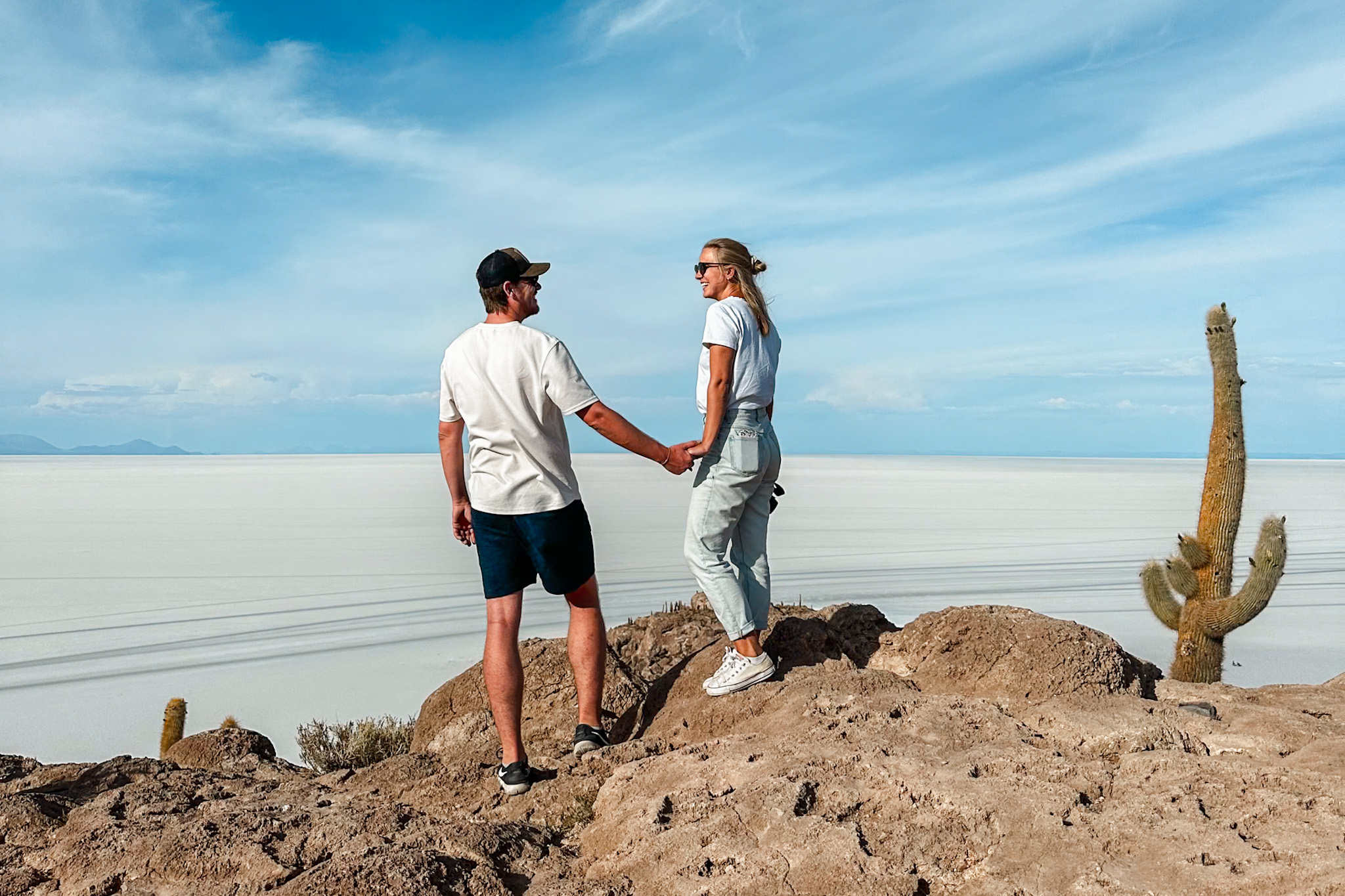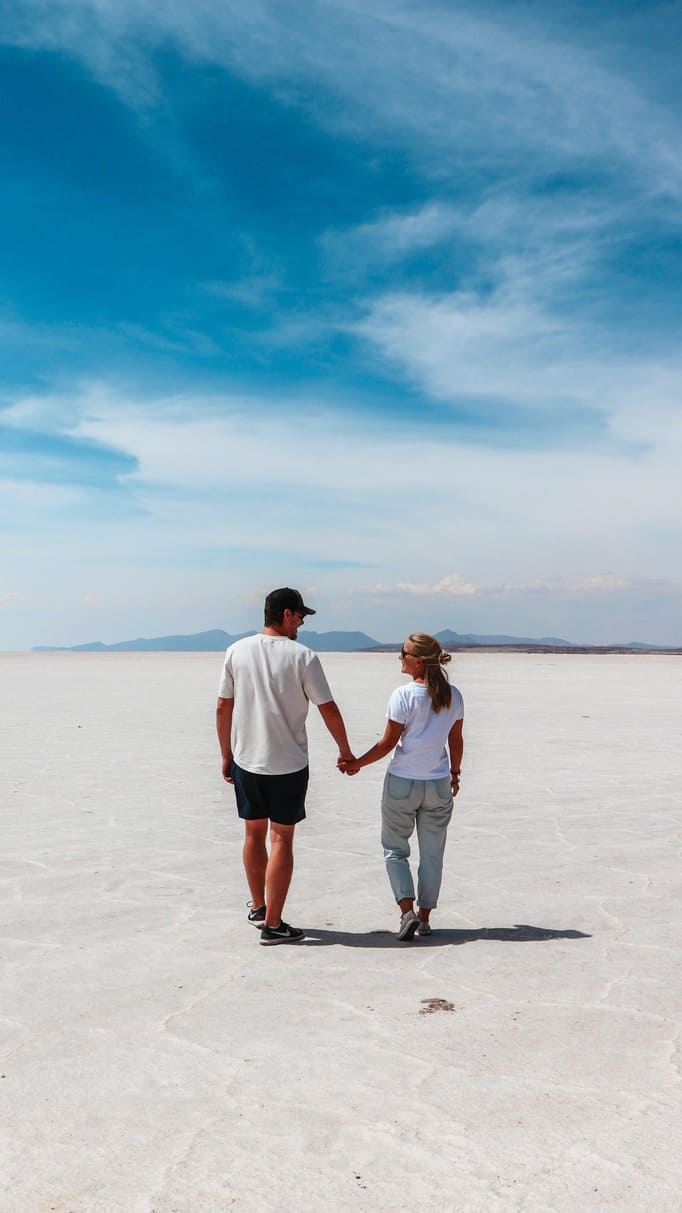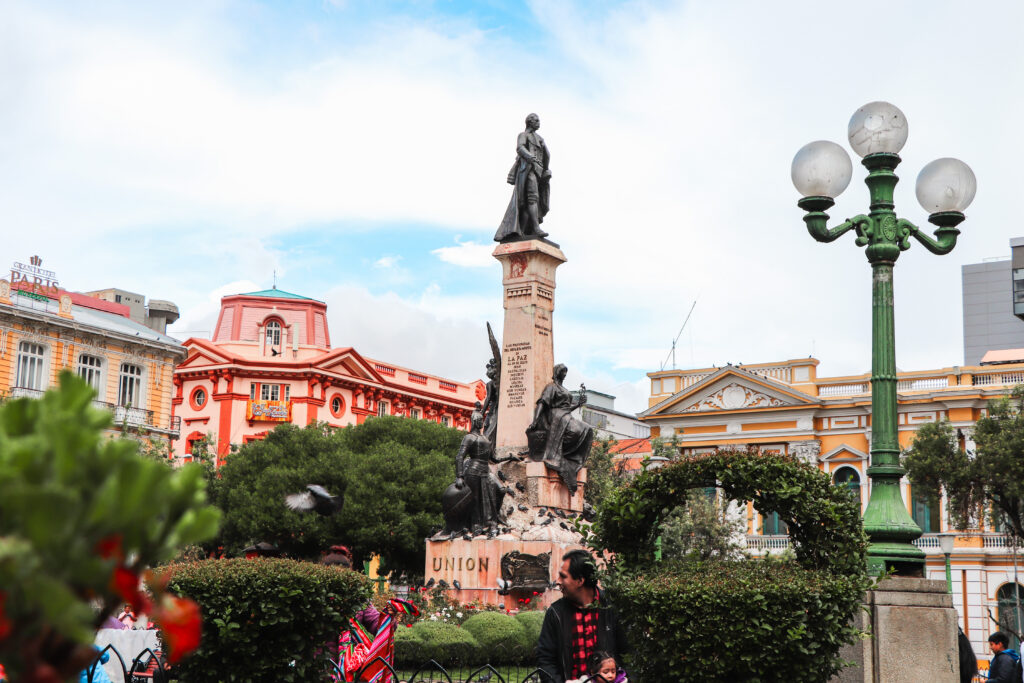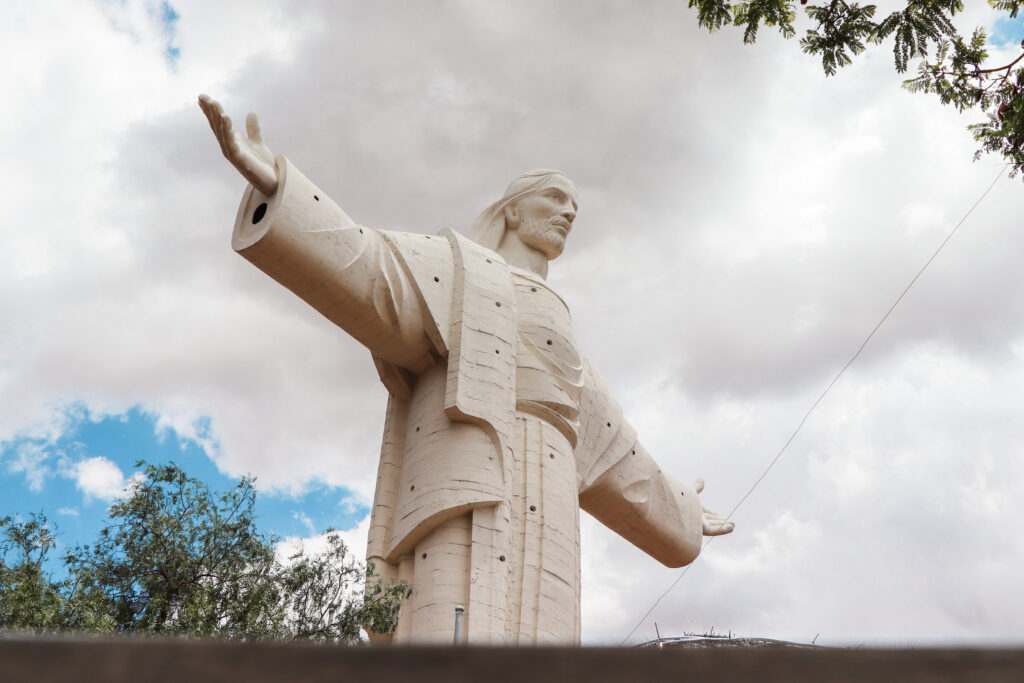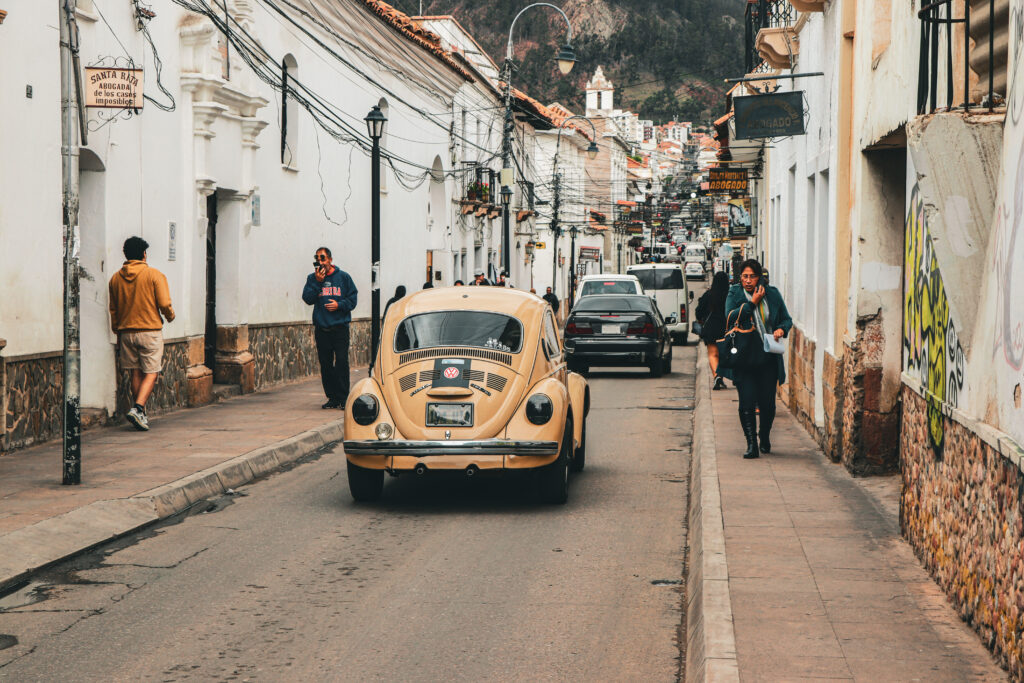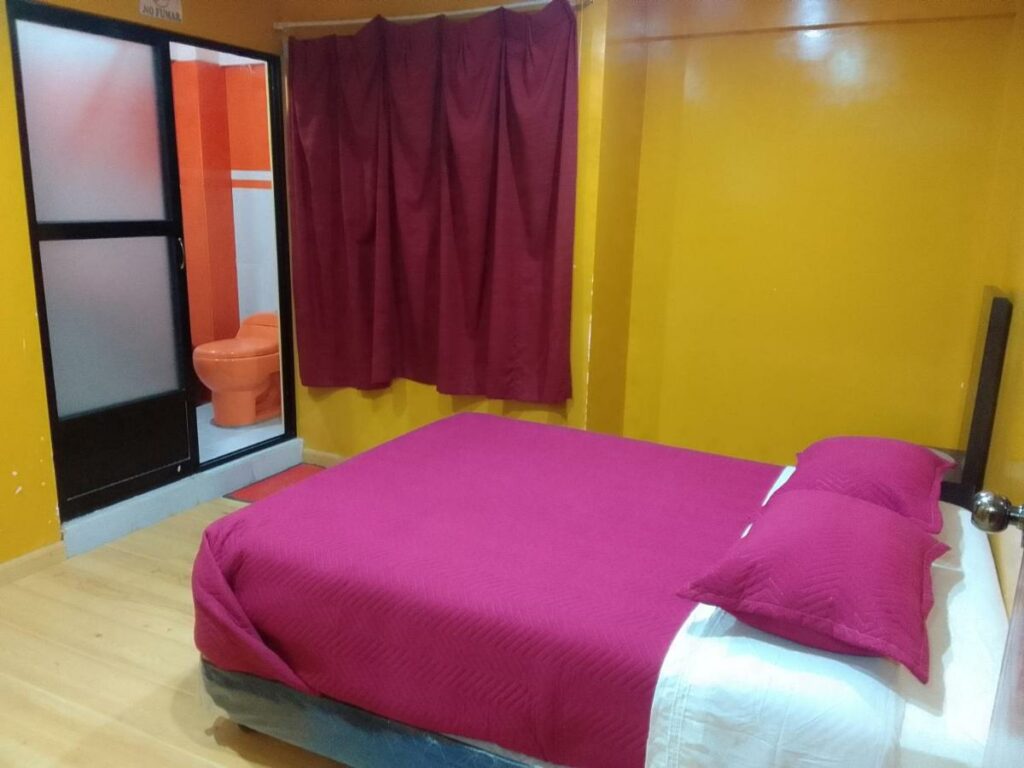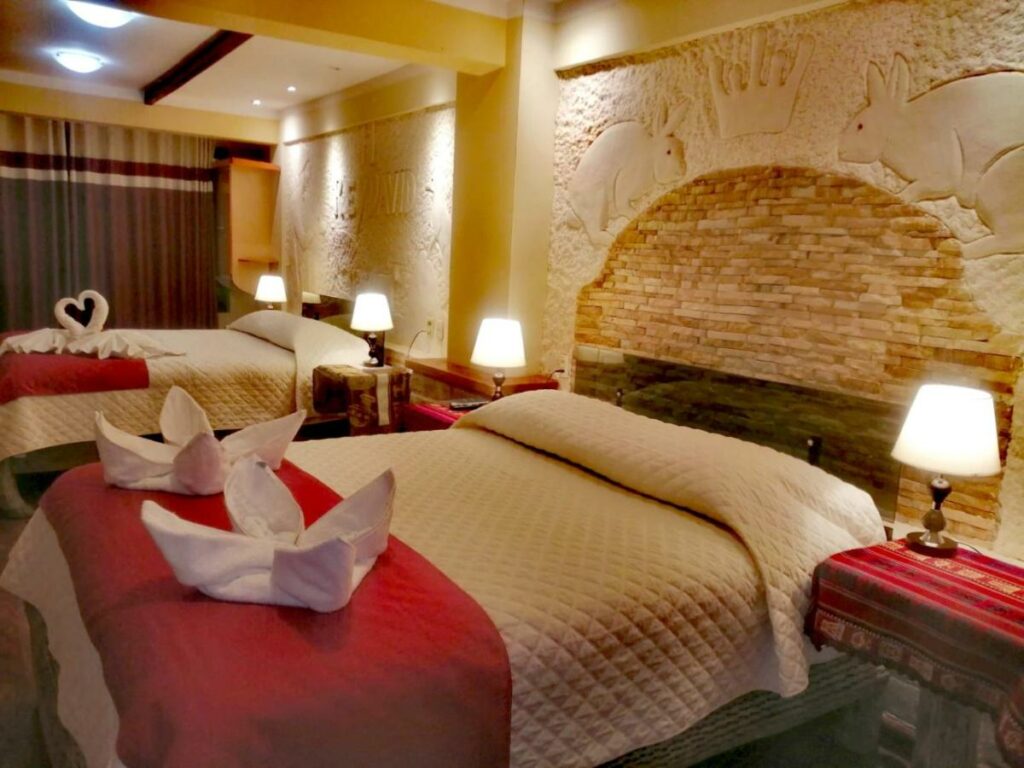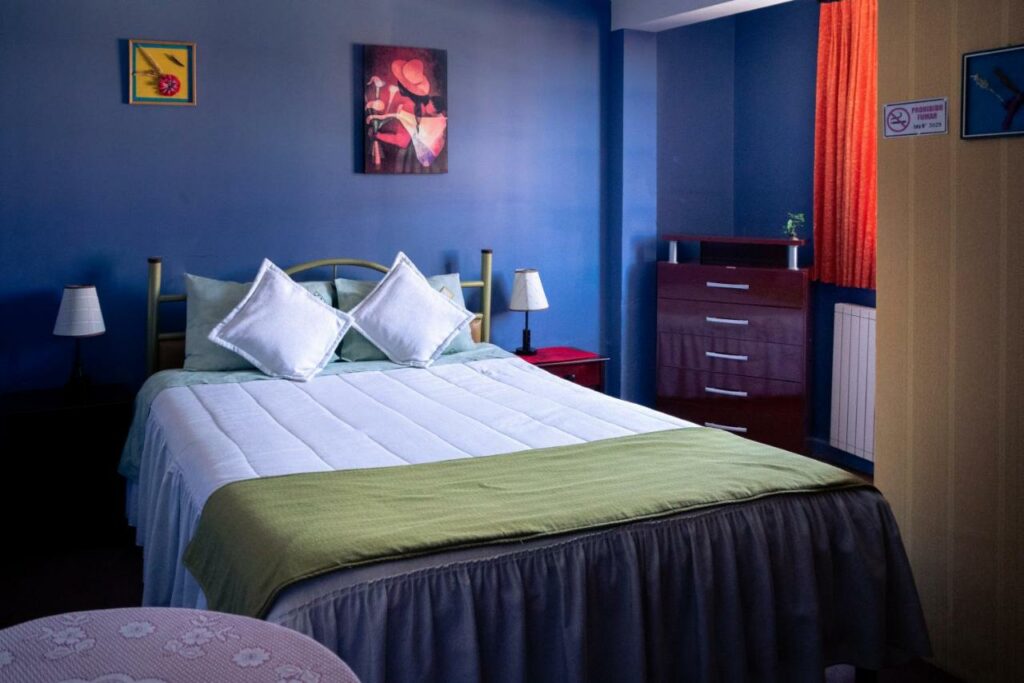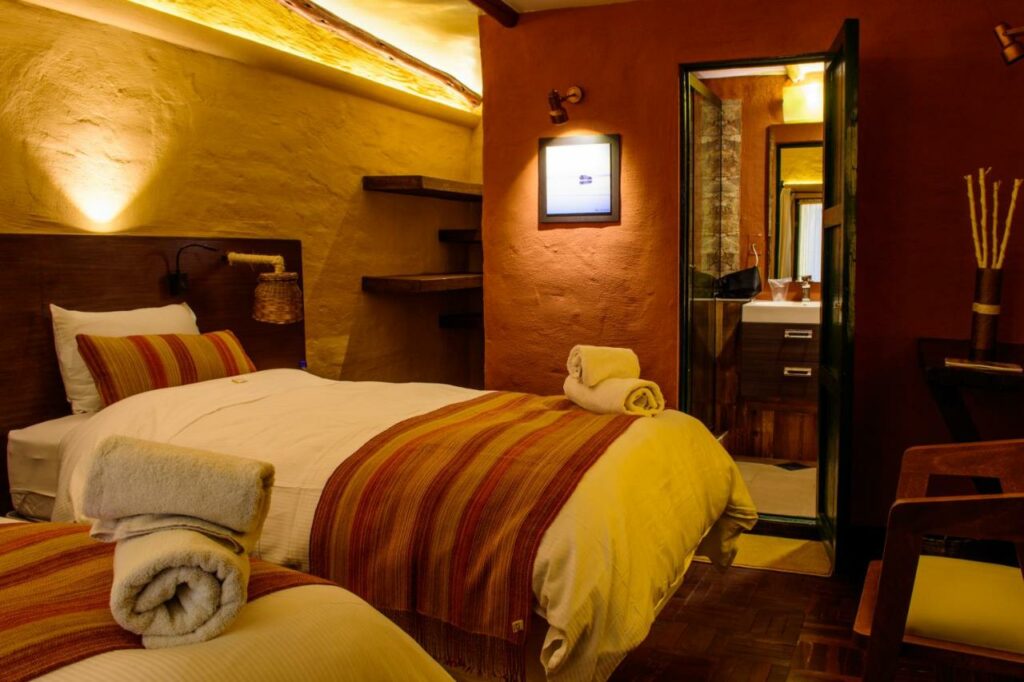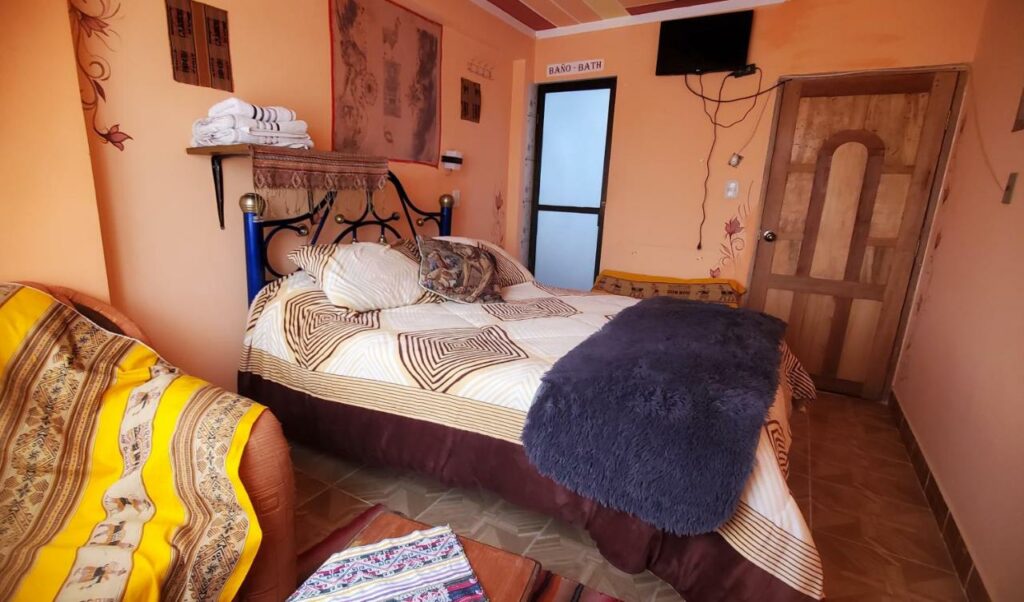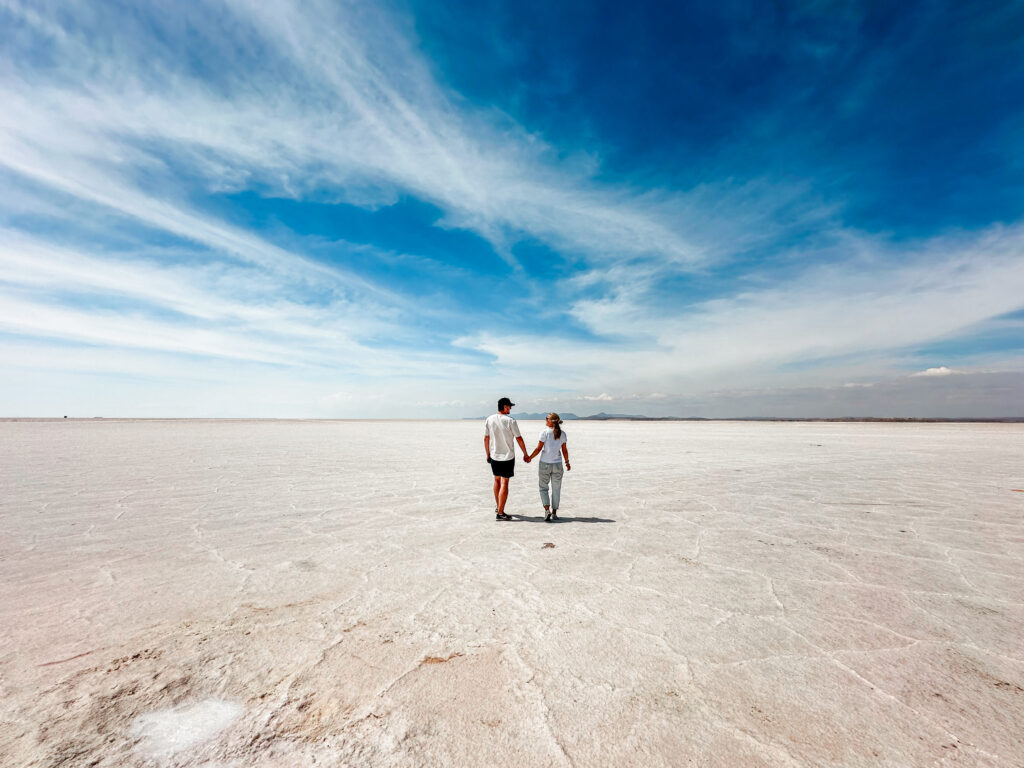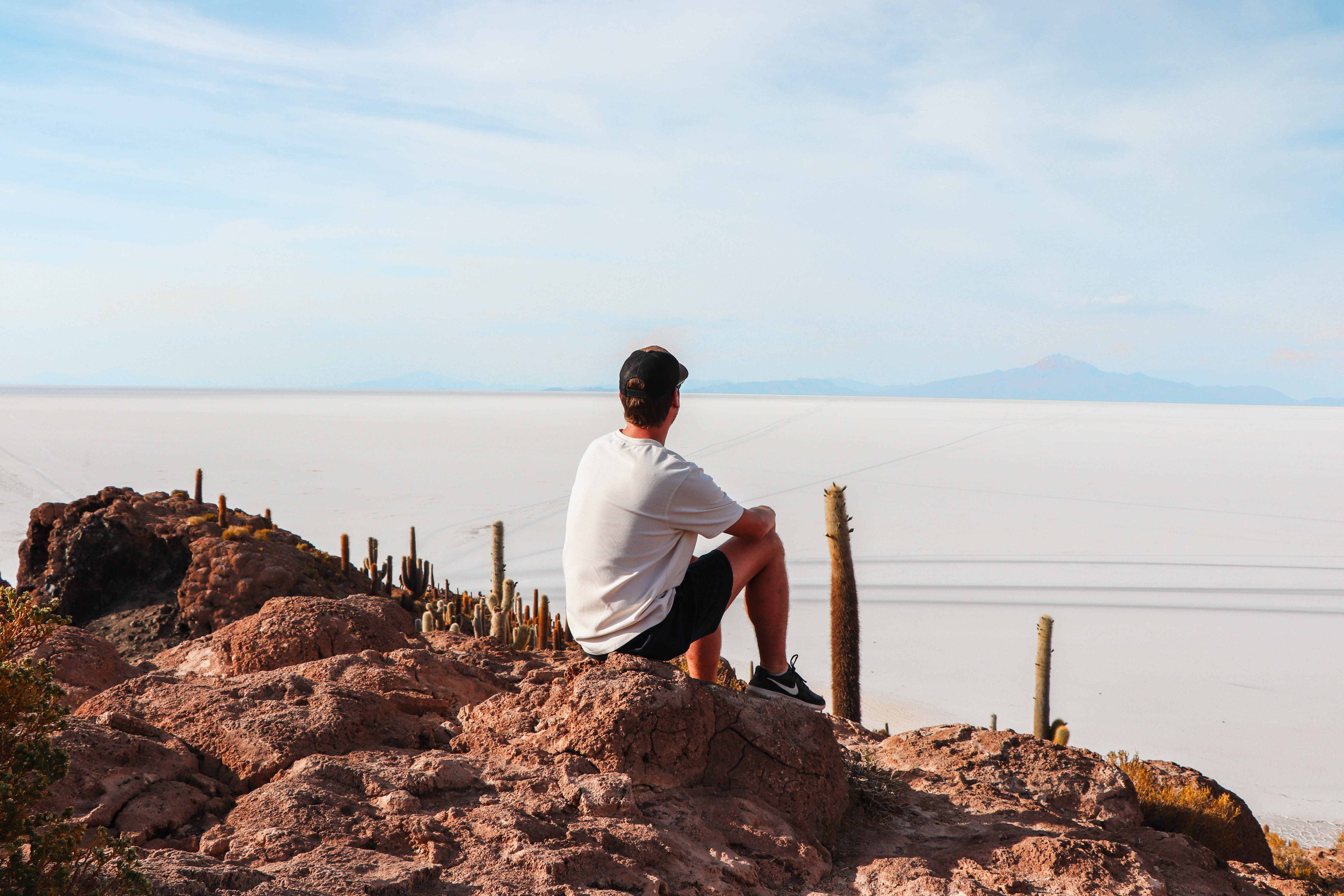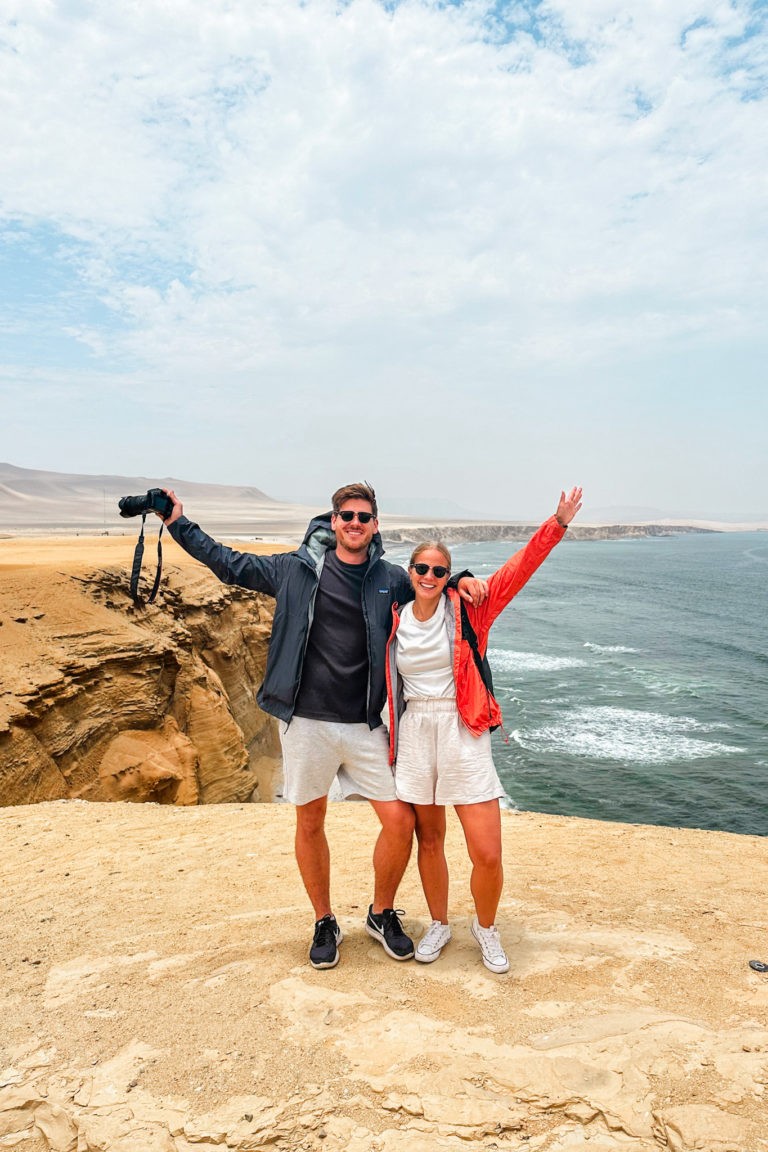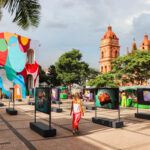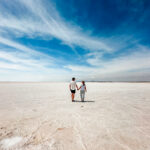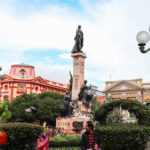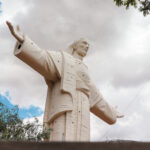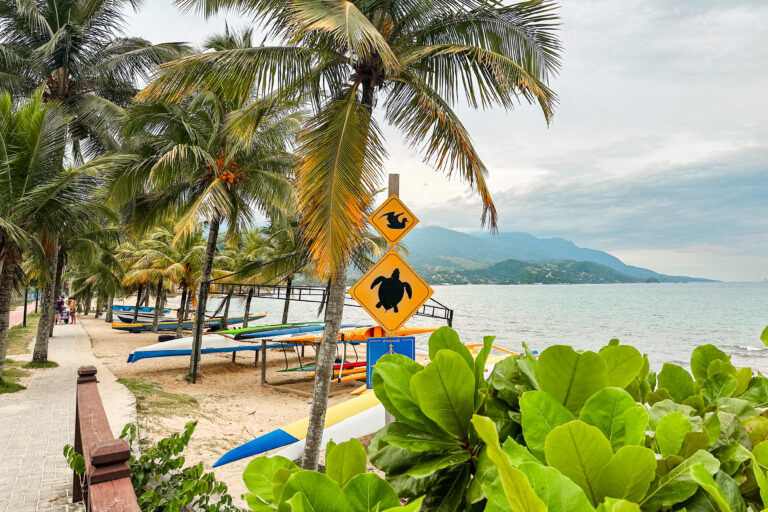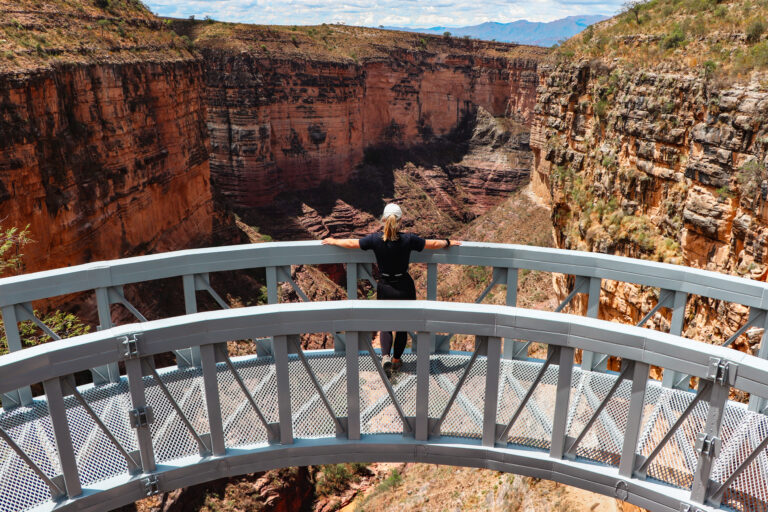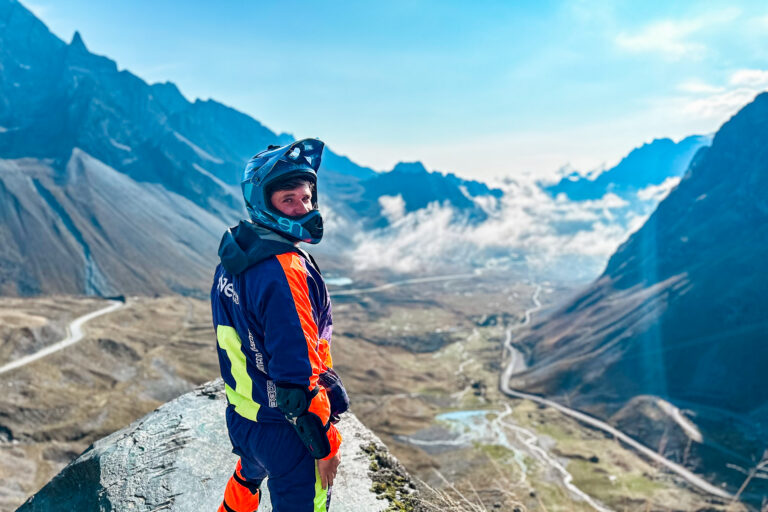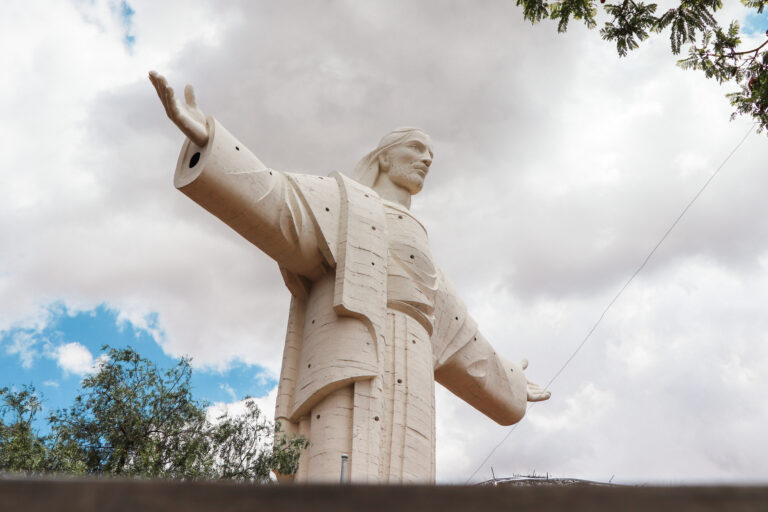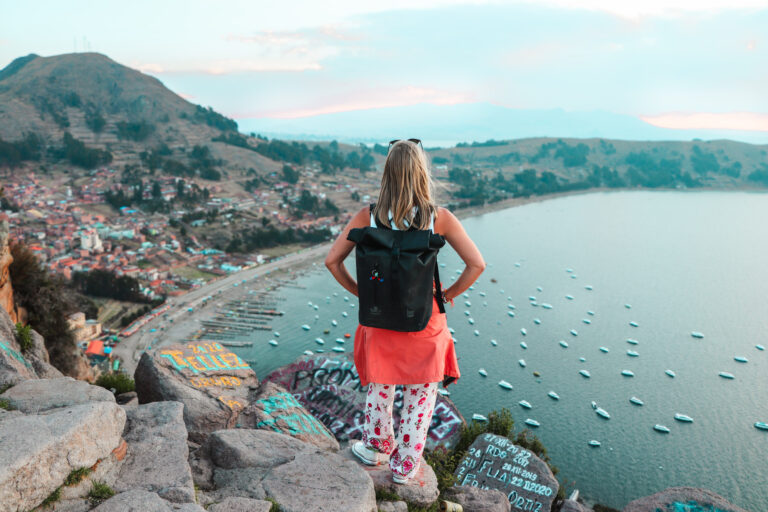Visiting the Salar de Uyuni, the world’s largest salt flat located in southwest Bolivia, belongs to the bucket list of South America. Roaming the Uyuni Salt Flat and the surrounding deserts and lagoons is not like a trip to another planet but rather like visiting 7 different planets. We could barely believe how unique and stunning landscapes we crossed during our three-day tour.
Our Uyuni Travel Guide summarizes everything you need to know before heading to the salt flat. We share helpful tips on how to best visit Salar de Uyuni, including how many days to plan and which tour to book.

What to see and do in the Uyuni Salt Flat
The Uyuni Salt Flat is one of the must-visits in Bolivia, and for good reason. We had heard from other travelers that it was the absolute highlight in Bolivia. But it still exceeded all our expectations.
Over a three-day tour, we drive into the vastness, crossing deserts, passing peculiar rock formations, towering volcanoes, steaming geysers, colorful lagoons full of pink flamingos, grazing vicuñas, and even chinchillas. If these sights fail to amaze you, then we’re not sure what will.
Below is a list of the best things to see and do in and around the Salar de Uyuni. Depending on the length of your tour, you may visit only a selection of them. However, typically, for a 3-day tour, most agencies follow a similar itinerary, including the following highlights:
1. Visit the Train Cemetery
Just a few kilometers from the city center lies a final resting place for old trains once used to transport minerals across Bolivia, Chile, and Argentina. Wander among the rows of trains and climb onto the roof of one of the rusty locomotives for unique photos. This place turned out to be much cooler than we expected. Our group was lucky to arrive at this place last and enjoy the site only by ourselves for a while.
The Train Cemetery gets quite crowded in the morning when all tours stop there for a visit. If you’d like to see this site without any tourists take a short afternoon walk the day before your tour starts. It’s only an 10-minute walk from Uyuni town. After all tours have left, there’s literally nobody there anymore.
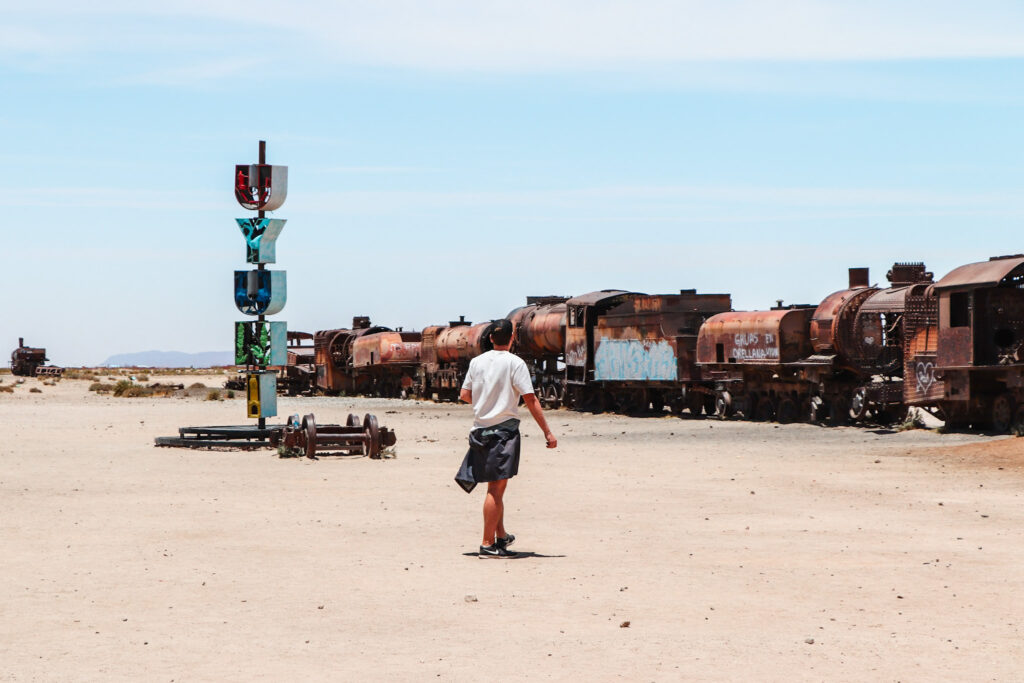
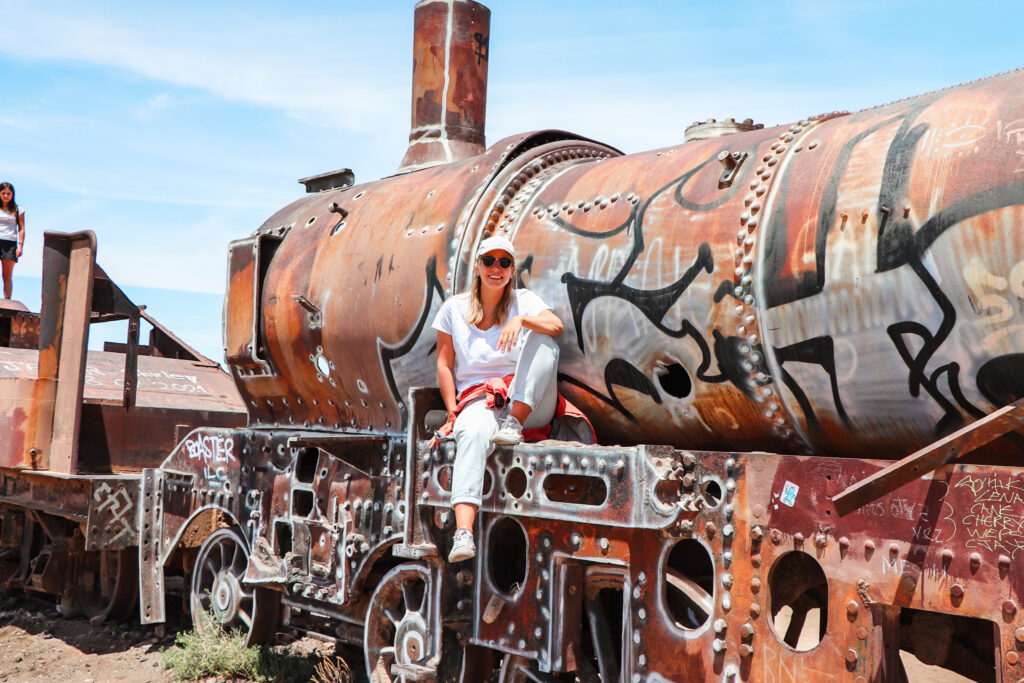

2. Learn about salt harvesting in Colchani village
Before heading to the salt flat, you’ll visit a salt factory in the village of Colchani for insights into salt harvesting. Though it’s more a sales event than anything else and it was our least favorite part of the tour. But if you are looking for great souvenirs, then here you’ll definitely find a great variety.
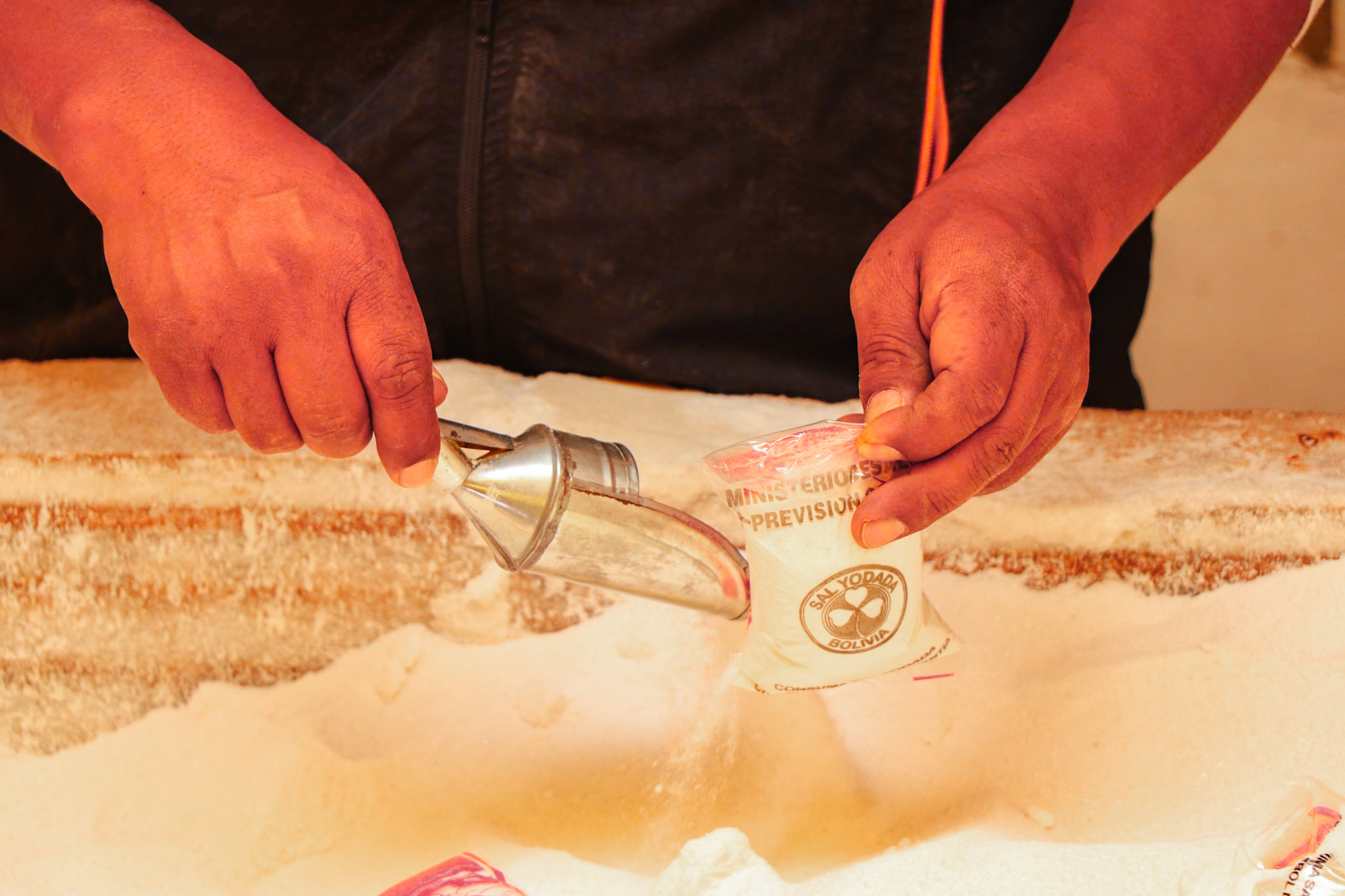
3. Get blinded by Uyuni Salt Flat
Everything is white, as far as your eyes can see. And there is nothing but an endless road into nothing.
When we saw the Uyuni Salt Flat for the first time, we were amazed by the sheer size of it. They were way larger than we imagined, covering 10,000 square kilometers. That’s almost the size of Jamaica!
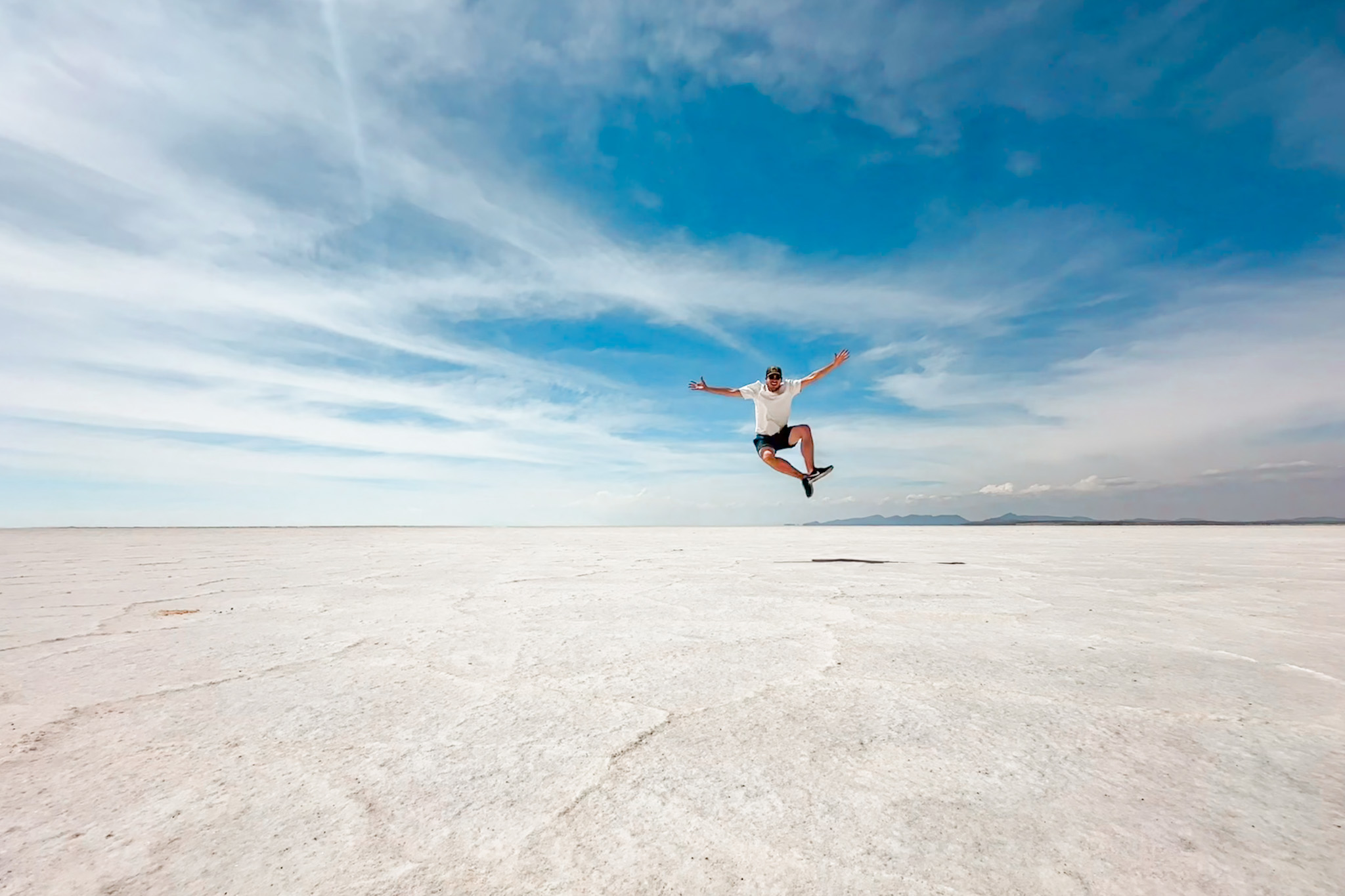
As we drove into the white, we had a flashback of us driving along the frozen Peipsi Lake in Estonia during winter, when it’s all covered in snow. But this time, we knew, we were far away from any snow. What a weird resemblance.
One of the first stops on the salt flat is Ojos del Sal (which translates to “Eyes of the Salt” in English) – where freshwater springs bubbling up beneath the salt crust. The Ojos del Sal vary in size and depth, with some reaching up to 10 meters (33 feet) deep!

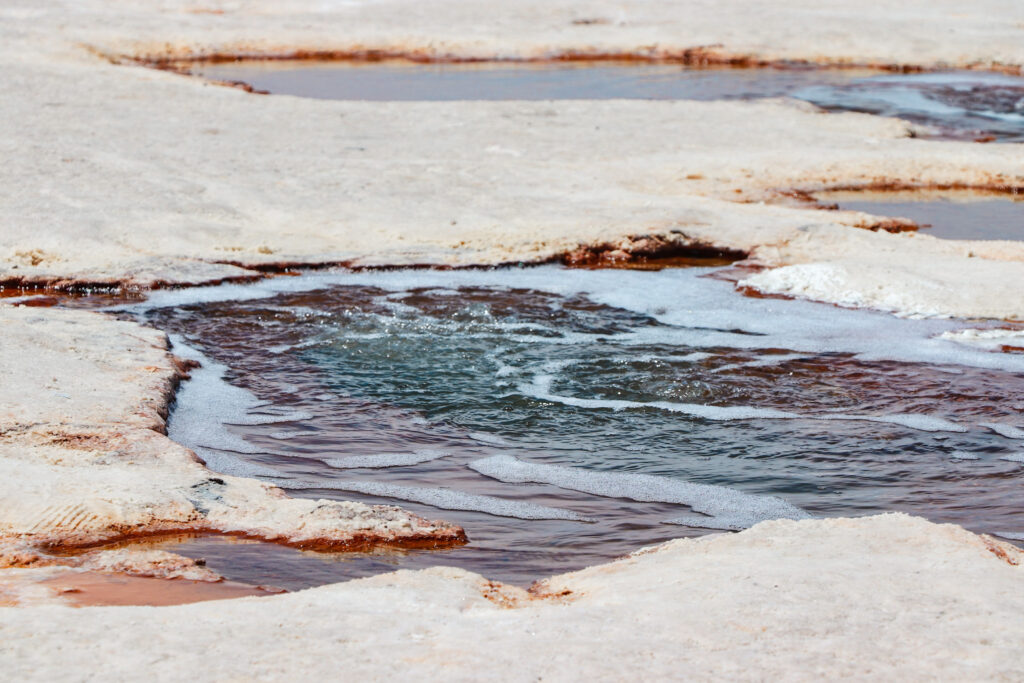
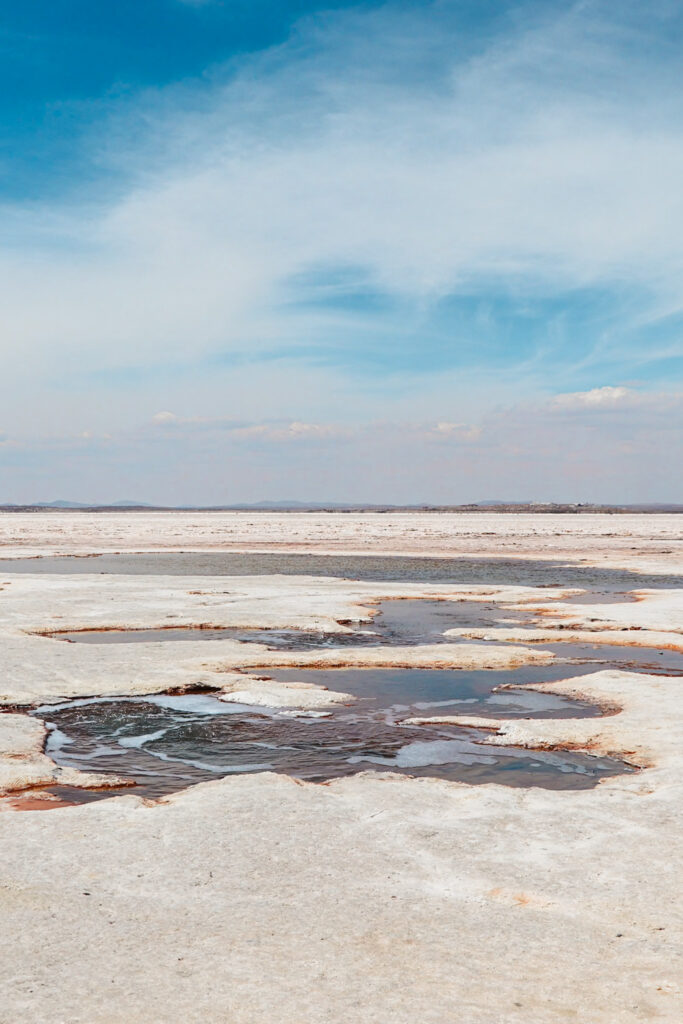
Afterward, you’ll also stop at the Dakar Rally monument, honoring the salt flat’s role as a race checkpoint, and at the Playa Blanco hotel, entirely salt-made, offering great photo ops among international flags.
Don’t miss the chance to take some funny photos playing with the perspective; it may feel silly at first, but it’s a lot of fun. Hopefully, your guide will have some creative ideas in his sleeve, but it’s also worth looking online for inspiration.
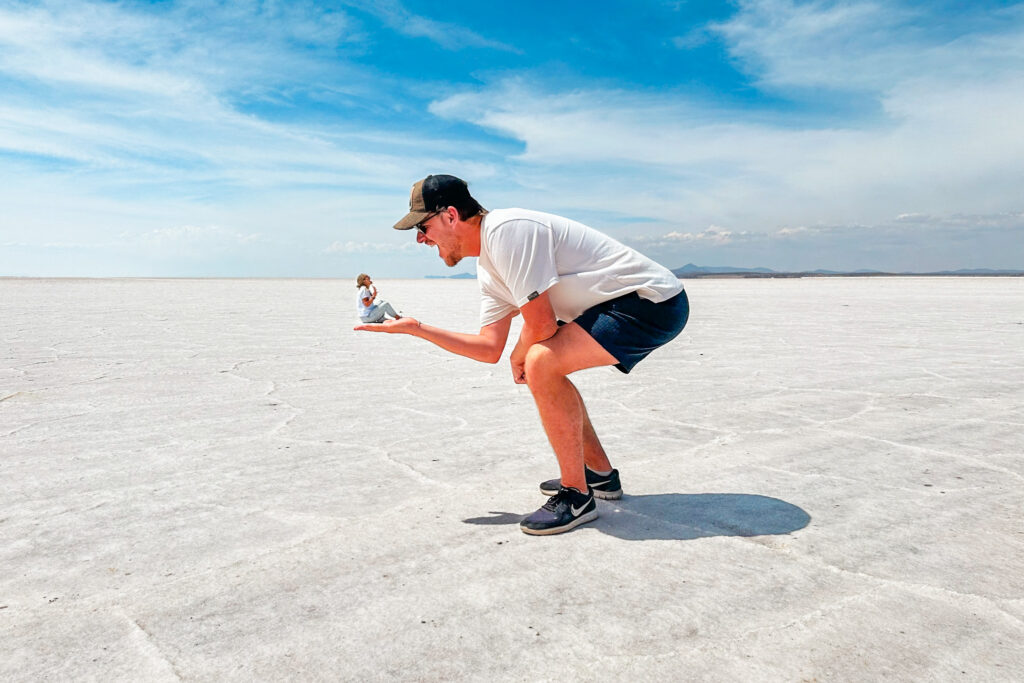
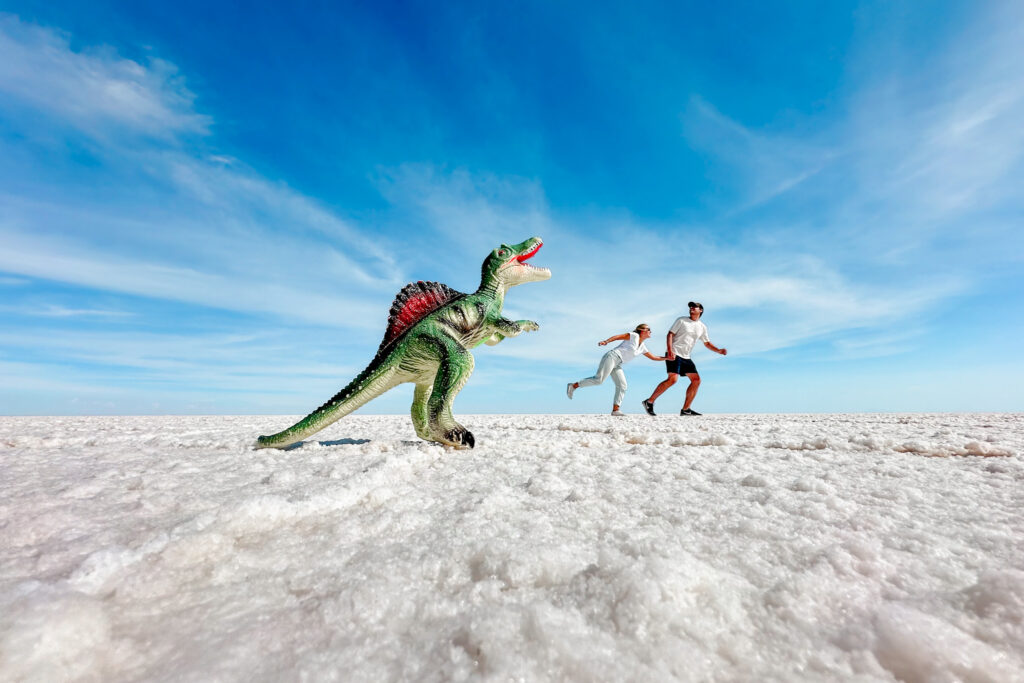

4. Hike on top of Isla Incahuasi - The Cactus Island
Isla Incahuasi was probably our favorite place in Salar de Uyuni. It is so surreal. Not only is there an “island” rising out of the ground in the middle of nowhere, but it is full of giant cacti.
It is worth it to climb the hills for great panoramic views over the salt flat. As the sun began to set, bathing the landscape in soft orange sunlight and casting silhouettes of distant mountains, we were simply filled with awe. Little did we know, this breathtaking moment was just the beginning of many more unforgettable views on our trip.
The entrance to Isla Incahuasi is 30 BOB (≈ 5 USD) and it’s usually not included in the tour price. So make sure to bring cash to pay for the ticket.
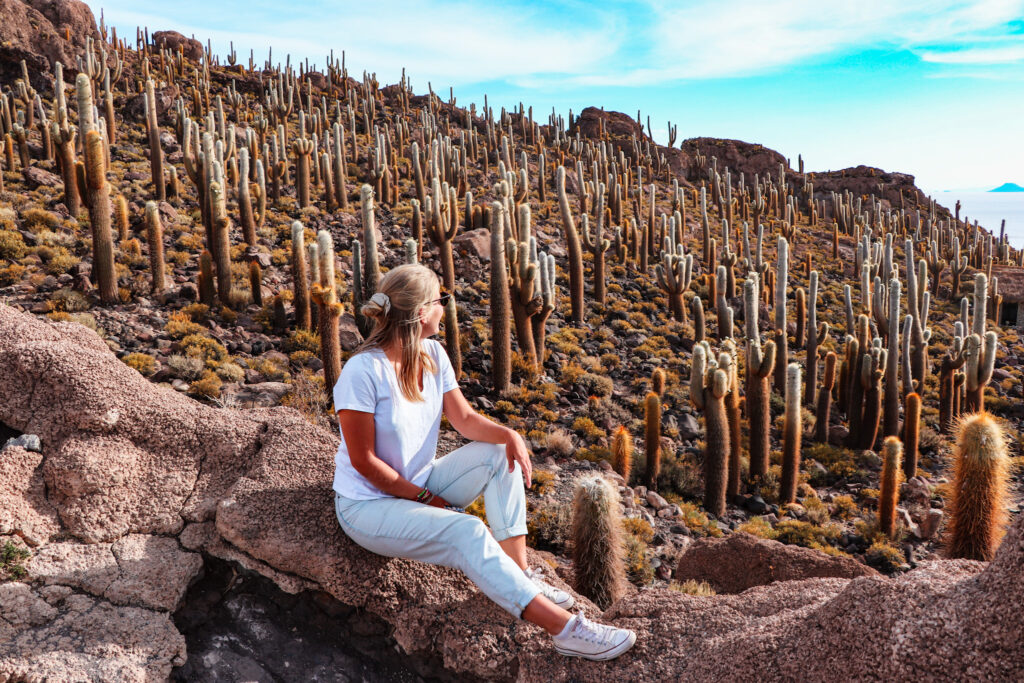
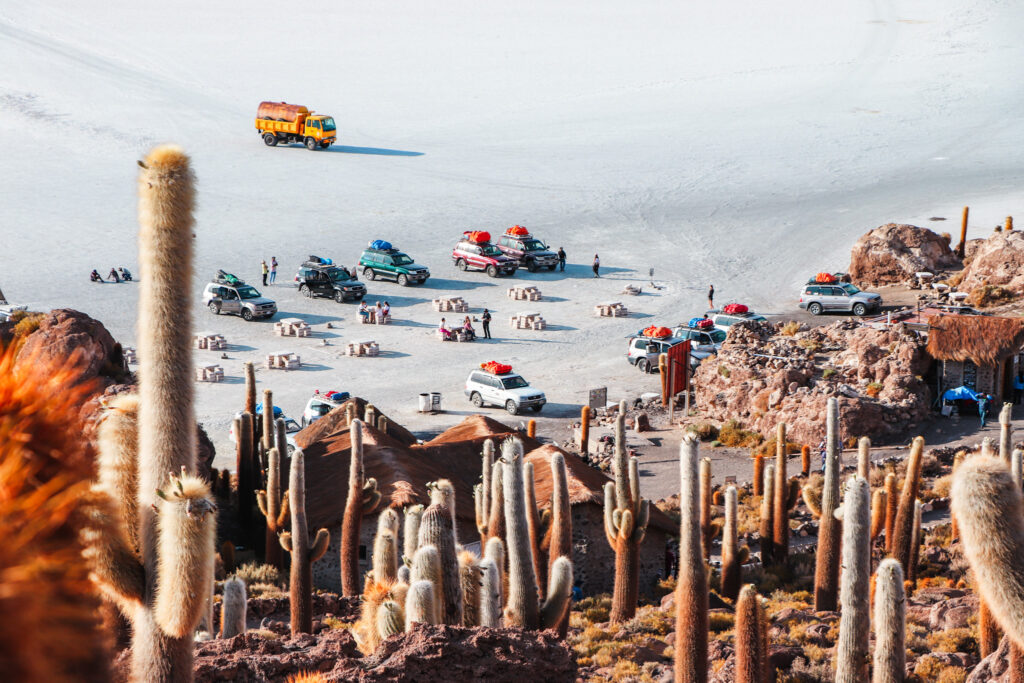
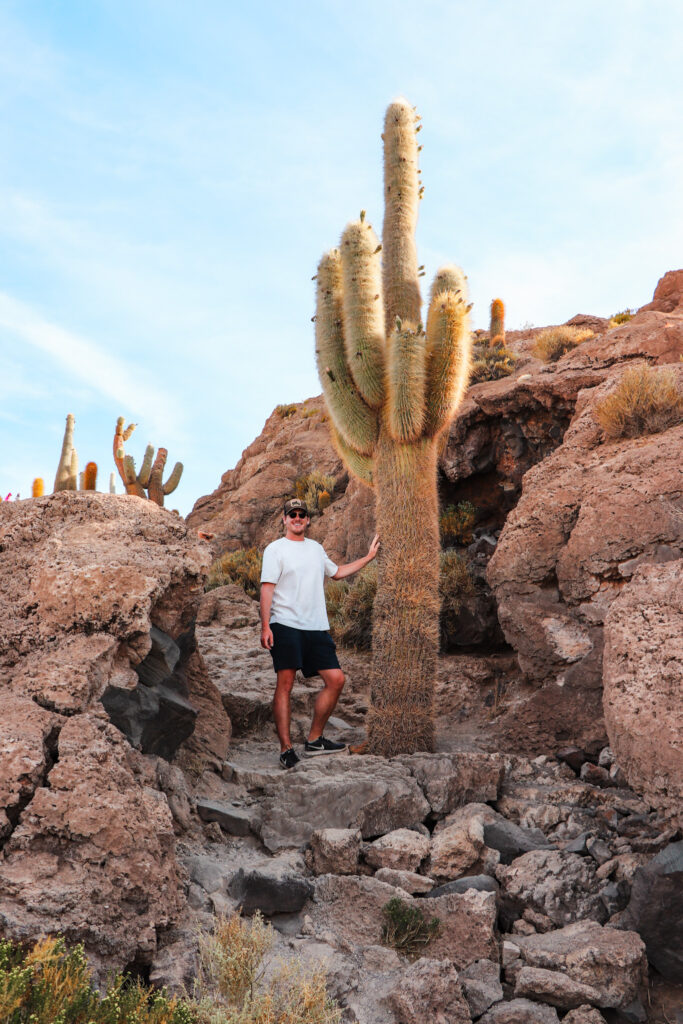
5. Escape the impossible Salt Labyrinth
As our guide asked our group whether we would like to explore a salt labyrinth, we were not sure what to expect. We had no idea how much fun it would be!
The labyrinth has high walls built of salt bricks and your goal is to find the exit. Boy was it hard. After looking around every corner we finally ended up at the entrance again. Trying to outsmart the maze, we decided to enter from the exit to find the missing connection to the entrance, only to end up with the same result.
Until today, we still believe that the entrance and exit of the labyrinth weren’t connected at all. We even climbed on some bricks to solve the puzzle but with no success.
So, unless you prove to us that it is actually possible to complete the labyrinth, we will forever talk about this as the ‘impossible labyrinth’.
The entrance to the salt labyrinth was only 10 BOB (≈ 2 USD). In case you would like to accept the challenge, make sure to bring cash to pay for the ticket, as it is not included in the tour price. And please let us know in the comments if you found the way out!
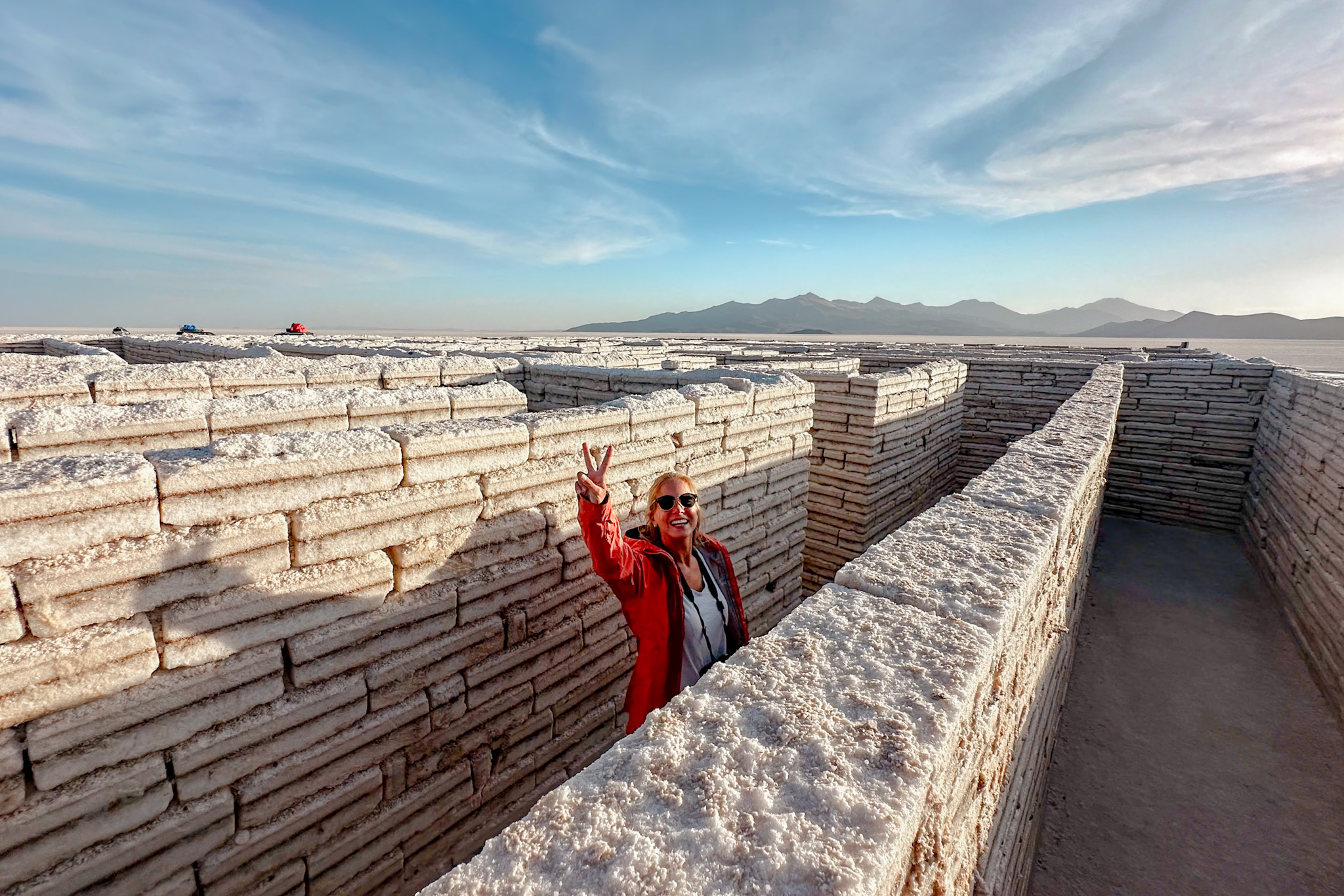
6. Enjoy magical sunsets
Undoubtedly, Salar de Uyuni is most beautiful when the sun is going down and the sky is painted in all shades of violet and pink. On our way to the hotel, our guide made a small stop at the roadside. We had a glass of local red wine and enjoyed the magical sunset. The sunsets were our favorite moments of the tour.

7. Do some stargazing
In the Uyuni salt flat, the light pollution is very low, so you’re in for a treat with a night sky filled with stars (assuming the clouds stay away).
We were incredibly fortunate on our second day to have clear skies, offering one of the greatest views of the stars. Though it took a moment for our eyes to adjust to the darkness, soon the entire sky was filled with countless tiny, shimmering lights.
Beware, temperatures can drop below 0°C at night and it can get quite windy. Make sure to bring some warm clothes with you to enjoy the beautiful skies at night.
8. Walk on the train tracks in Salar de Chiguana
Driving through the Chiguana salt flat may not be as breathtaking as Uyuni, but it still offers beautiful views. The striking contrast of the white salt against the backdrop of reddish mountains and the high Volcano Ollaggüe creates a nice scenery. Here you can also walk along the historic train tracks that once facilitated the export of salt to Chile.

9. Watch Volcano Ollaggüe smoke
Volcano Ollaggüe is located on the border between Bolivia and Chile. It stands at an elevation of approximately 5,860 meters (19,226 feet) above sea level. Ollagüe is known for being active, with visible smoke rising from the volcano.
There’s a nice viewpoint to watch the spectacle. Sometimes, you could even hear the volcano “roaring”. The surrounding landscape is so surreal with curious rock formations that were probably formed millions years ago, as the hot lava once met the cold sea.
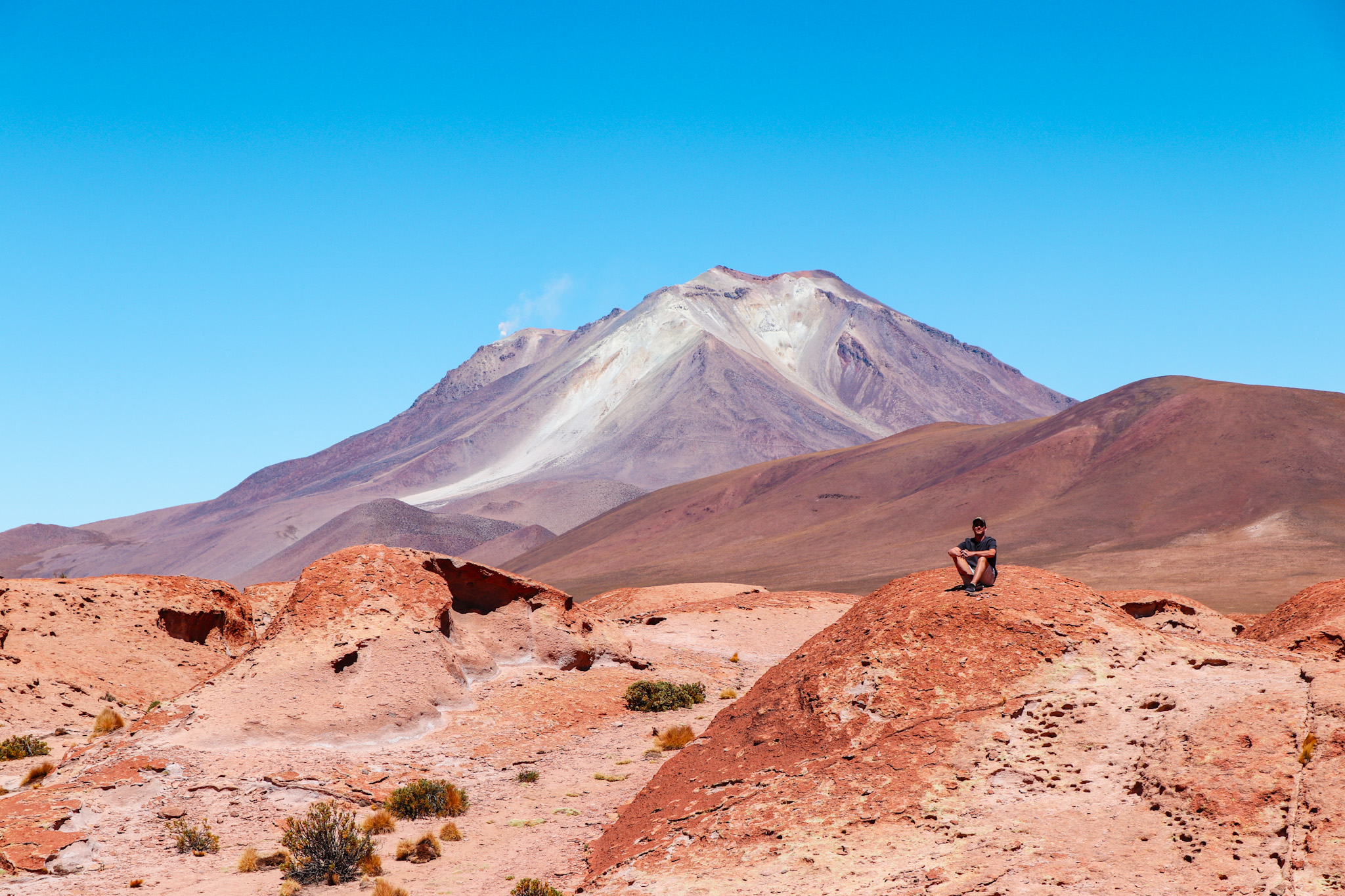
10. Observe flamingos in Lagunas Colores - Turquiri, Cañapa and Hedionda
What an extraordinary interplay of colors! Picture-perfect blue lagoons with white salt borders, occasionally being mixed with green sulfur. Swarms of pink flamingos gracefully wading through the water. And brownish-red mountains framing the landscape. One could not ask for more stunning scenery for a lunch break.

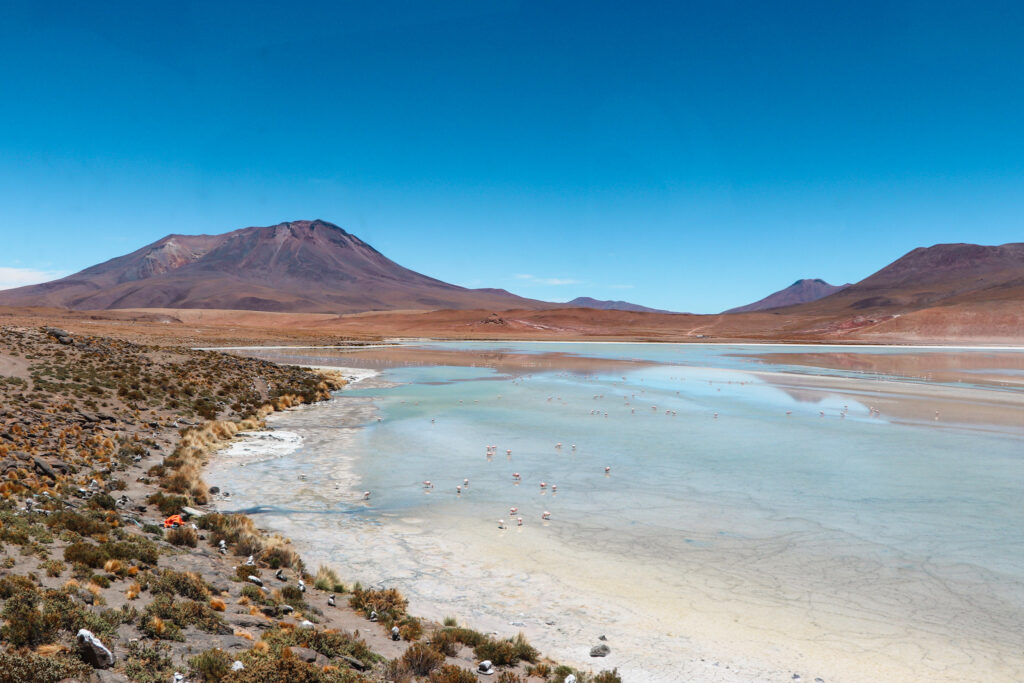
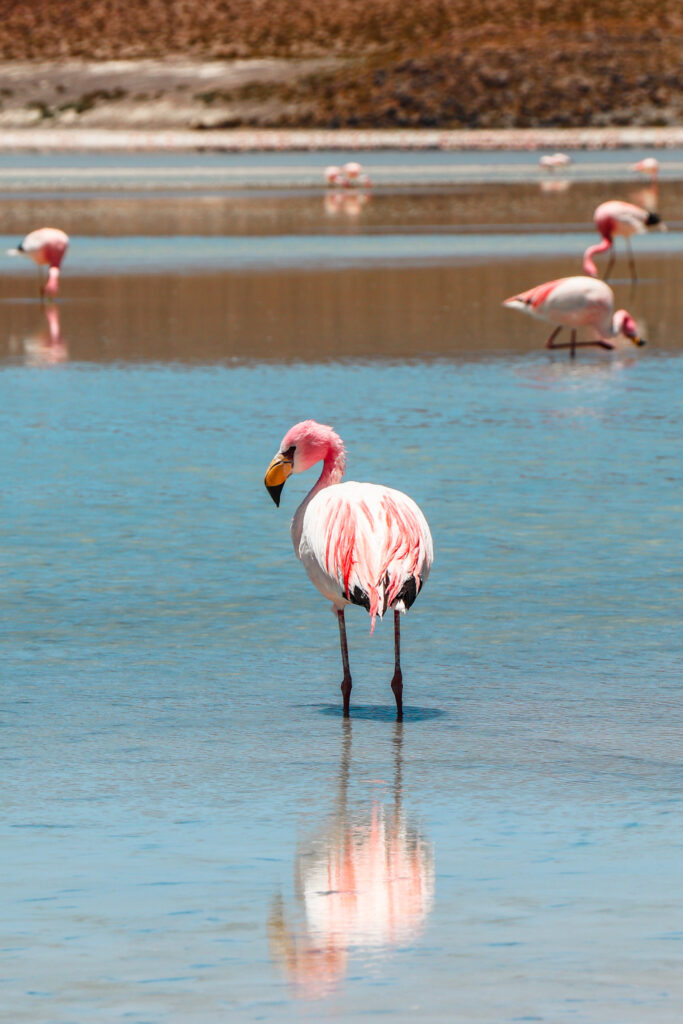
11. Explore Siloli and Salvador Dali deserts
Siloli and Salvador Dali deserts offer some more scurrilous rock formations. The most famous of them is the Rock Tree. It may start sounding like there are only rocks to see, but trust us, all of these are so unique in their way and put you in awe even if you are no geologist. But if you should get tired of all the stones, look for the adorable fluffy vizcachas here.
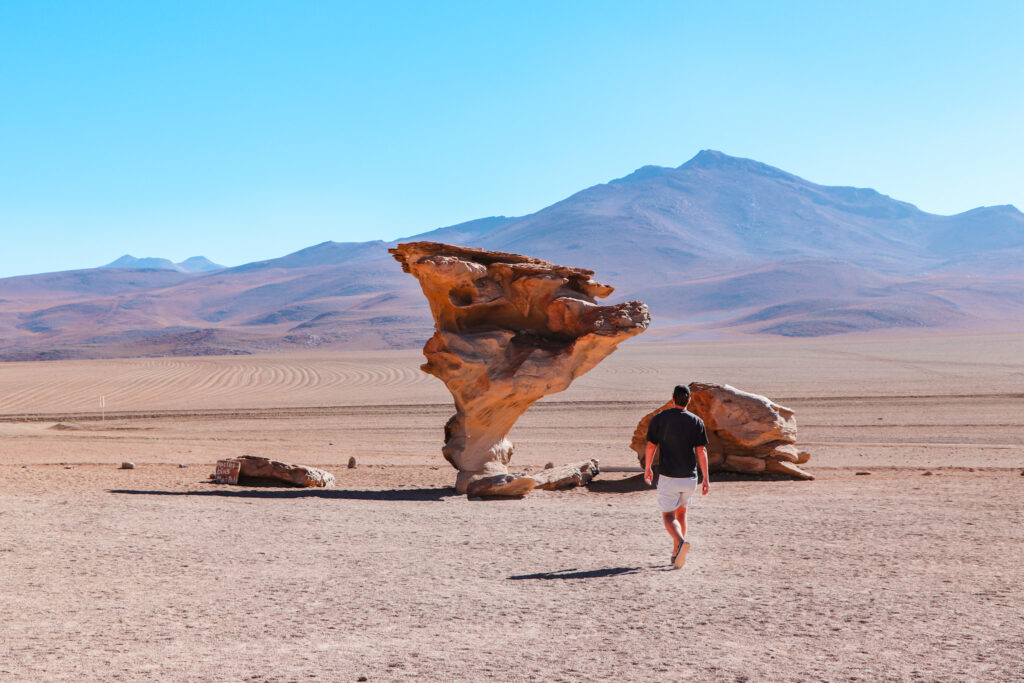

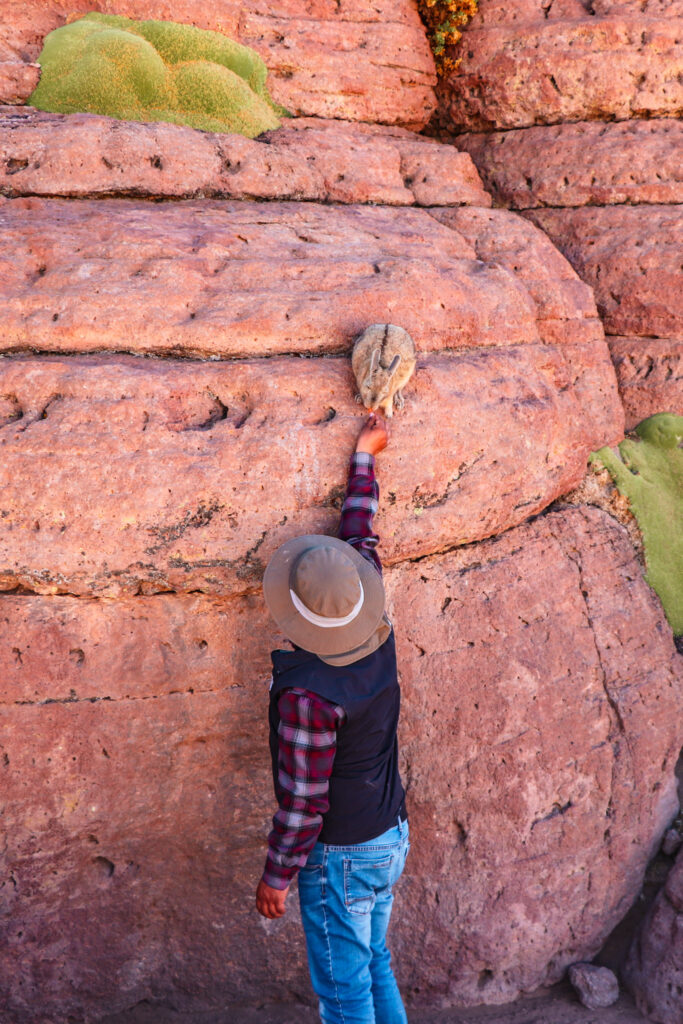
12. Admire Laguna Colorado in the Eduardo Avaroa National Reserve
To be honest, we don’t find any adequate words any more, to describe the beauty of this place. Unlike other lagoons, this one stands out for its striking red color. It truly feels like nature’s masterpiece. What makes it even more exceptional is the opportunity to spot three different species of flamingos here. We let the pictures speak for themselves.
The entrance to the national reserve of Fauna Andina “Eduardo Avaroa” is usually not included in the tours. The ticket costs 150 BOB (≈ 23 USD) and can only be paid in cash.

13. Be left breathless by “Sol de Mañana” Geysers
As the early morning sun casts its first light, you see steam rising from the earth. These are geysers. Upon opening the car door, the air is heavy with the scent of sulfur. This otherworldly experience makes the early 4 am wake-up call unquestionably worthwhile.
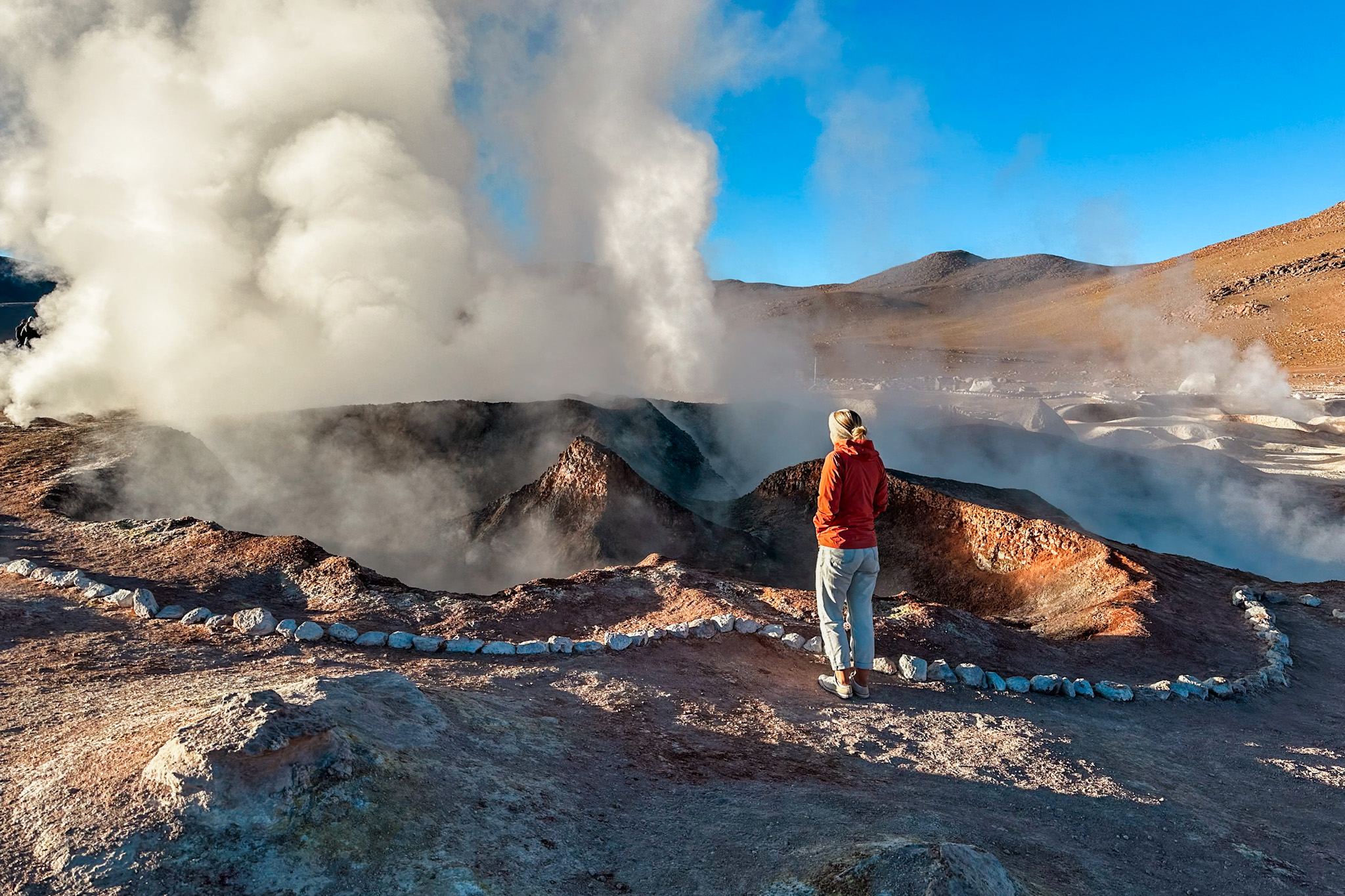
14. Warm up in the hot springs
Taking off your clothes is the last thing you would think about in the crisp morning air, with temperatures below freezing. But trust us, it will be the best decision of the day. The water in the hot springs is over 35 degrees Celsius and it’s just a perfect way to warm up your bones again.
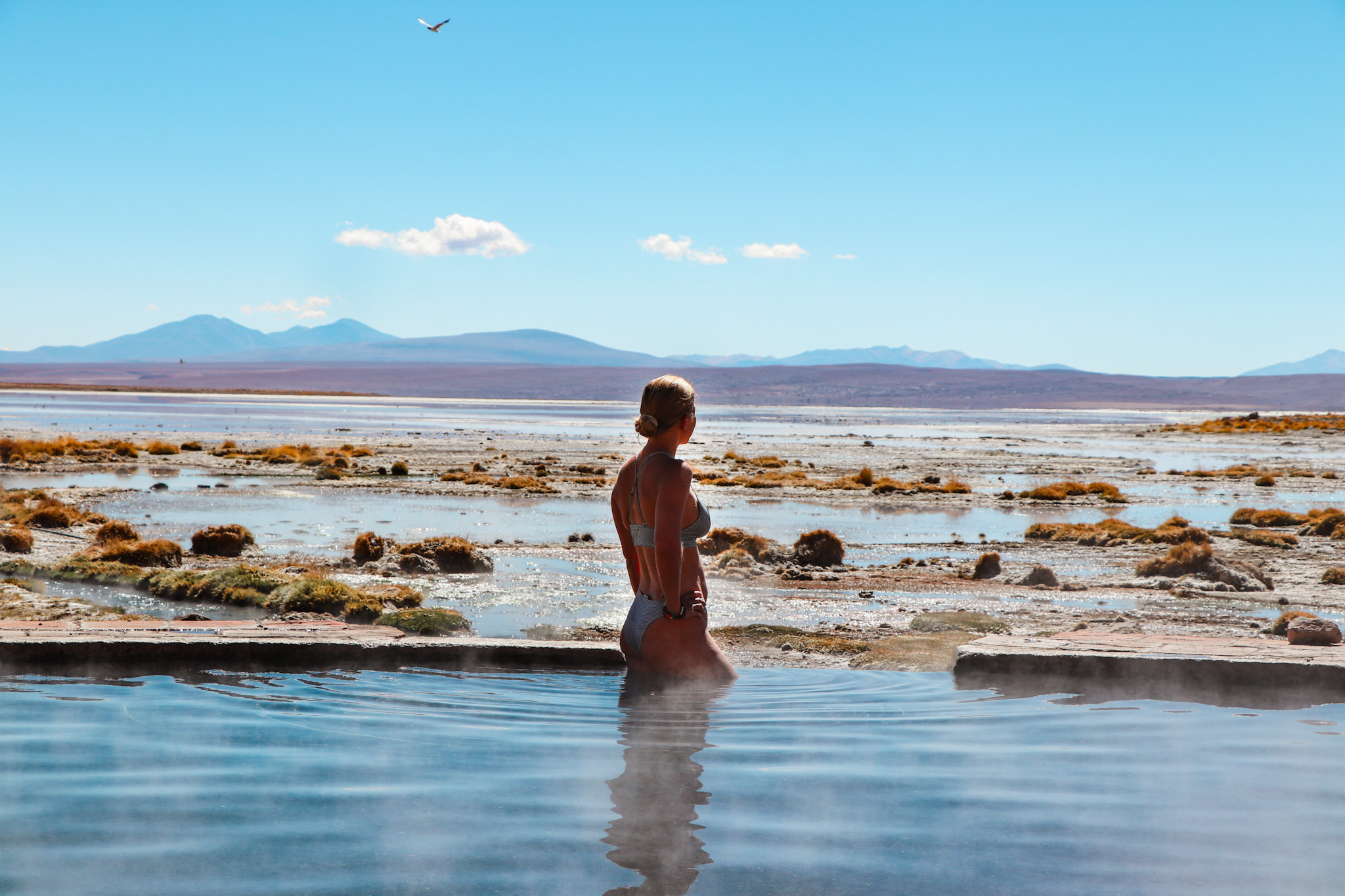
How many days do I need to visit the Uyuni Salt Flat?
If your focus is on visiting the Uyuni Salt Flat only, you can do it in just one day. A typical one-day Uyuni salt flat tour takes you through the amazing landscape, starting with the village of Colchani, followed by the artistic “Dakar” monument, the fascinating natural pools of Ojos del Sal, and finally culminating in amazing panoramic views from the giant cacti-covered Incahuasi Island.
However, we want to highlight once more, that the region offers so many more stunning landscapes beyond the salt flat that we believe are absolute must-visits. That’s why most travelers typically spend around 2 to 3 days exploring the Uyuni Salt Flat and its surrounding areas.
This allows for an even more breathtaking experience, including exploration of desert landscapes, and colorful lagoons, observing flamingos, and activities such as stargazing or relaxing in hot springs.
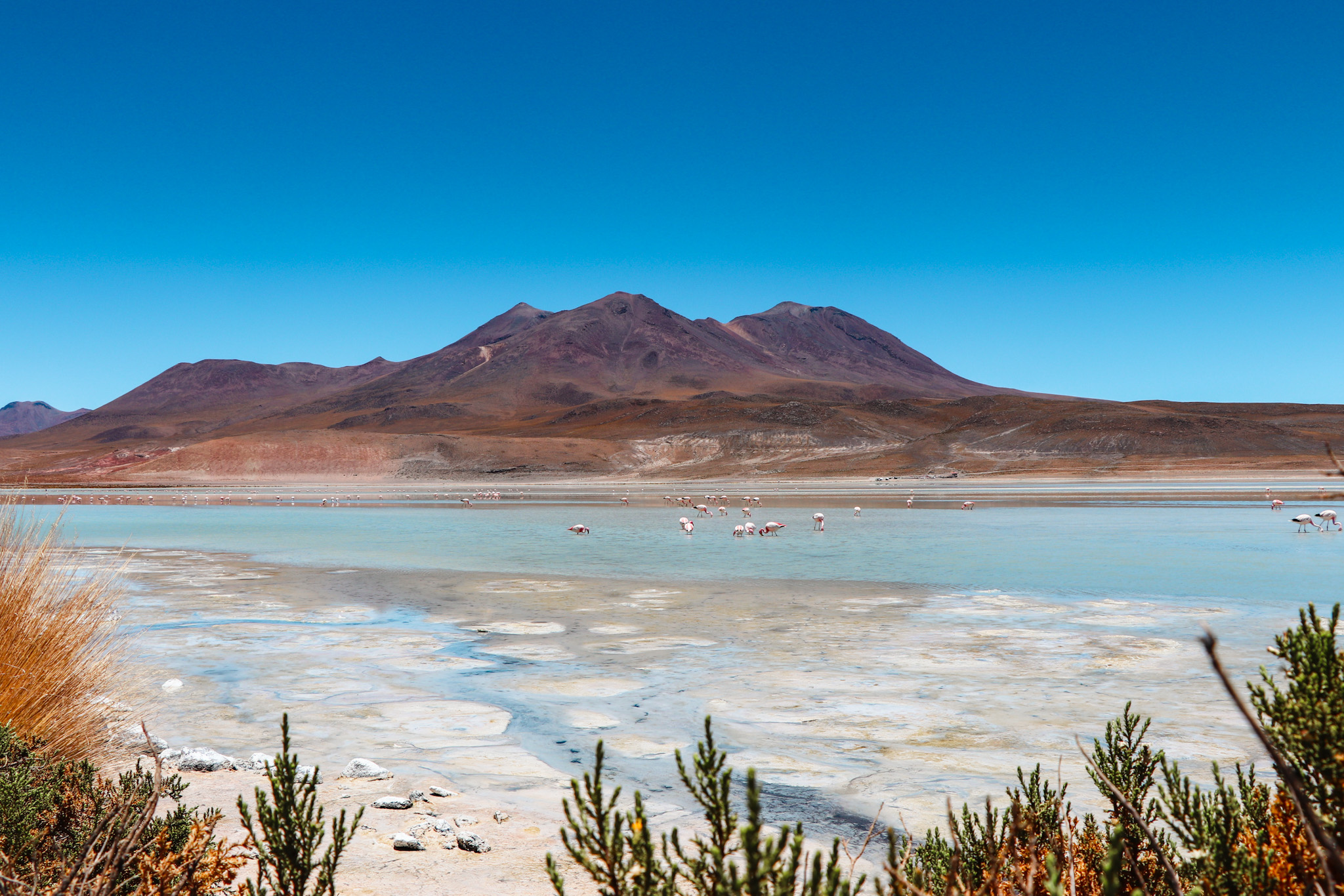
Do I need a tour guide to see the Uyuni Salt Flat?
The short answer is no, but -without a doubt- we would definitely recommend it. Not because it’s more convenient, but because otherwise you’ll be missing out on some equally breathtaking sites around the area.
If you’d still like to explore the Uyuni Salt Flat independently, you can take a bus from Uyuni town to the small villages of Colchani and Llica, where you can stroll out to admire the renowned salt flat.
While Colchani is at the beginning of the salt flat and perfect for a one-day tour, we would recommend driving to Llica which is further away, to be able to drive across the salt flat and get a glimpse of the iconic Isla Incahausi.
BUT, as we’ve said earlier, we find the surrounding landscapes beyond Salar de Uyuni equally breathtaking and think that they should not be missed. However, for seeing the colorful lagoons and geysers booking a tour becomes essential. In our view, this investment is well worth it, as the 3-day-tour was one of our absolute highlights when traveling South America.
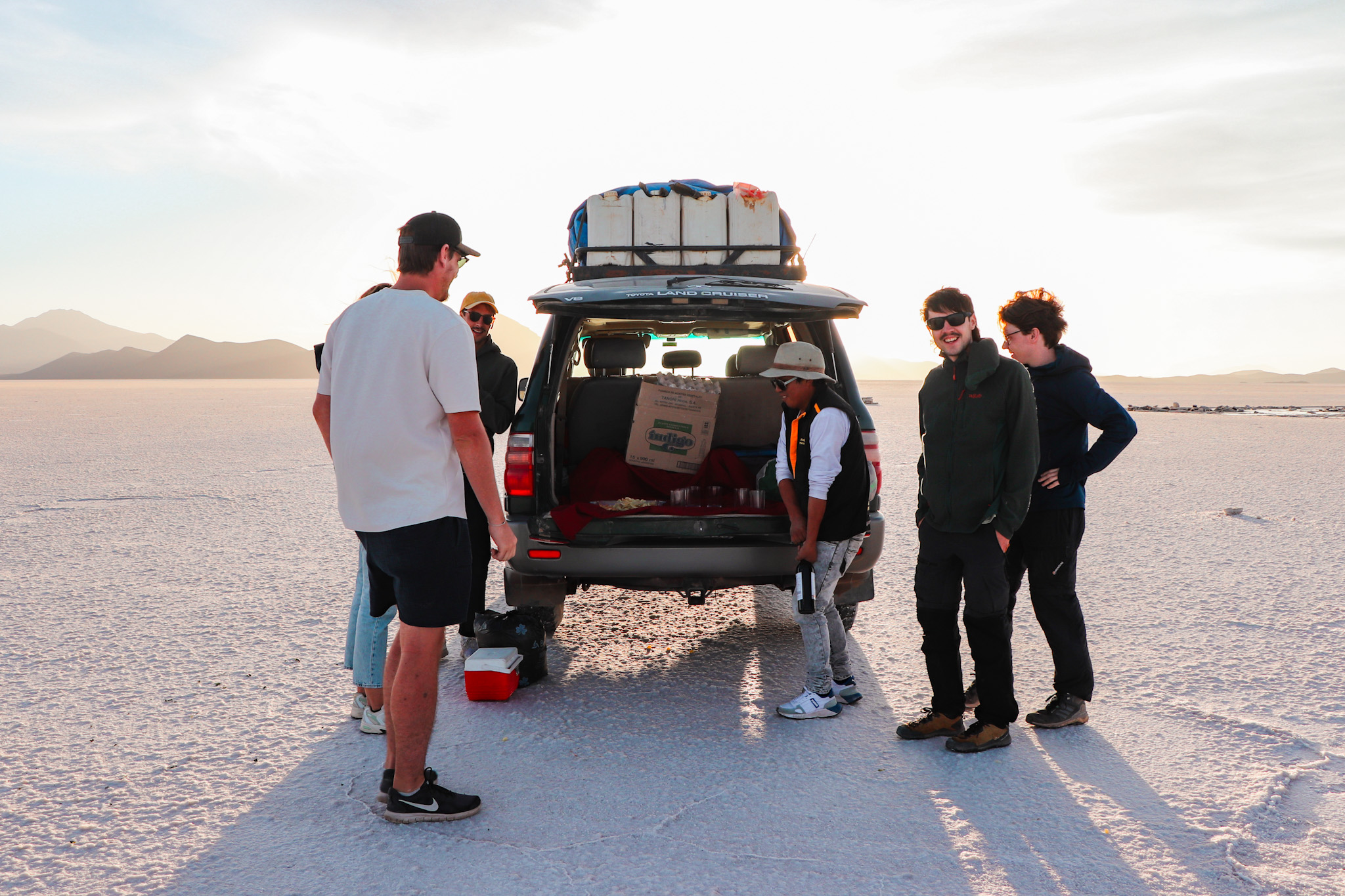
Which tour to book to visit Uyuni Salt Flat?
You can find several tour operators in Uyuni offering a variety of types of tour packages to explore the Uyuni Salt Flat and its surrounding attractions. You can choose from half-day tours to multi-day excursions, from private to shared tours, and from sunrise to biking tours.
It’s quite a challenge to review all the agencies. Prices vary significantly, and it’s often unclear what is included. Paying a bit more can mean better maintained cars and added comfort, such as private rooms, warm showers, and better meals, but that’s not always the case.
Some agencies mix travelers from different operators to fill 4x4WD vehicles. So it feels a bit like Russian roulette. You could end up with a different tour operator than the one you booked with. For this reason, we decided to book the cheapest option to avoid feeling cheated.
You can also start your tour to Salar de Uyuni from San Pedro de Atacama in Chile or from Tupiza in Bolivia near to Argentinian border. We have heard that these tours may even offer a better experience with fewer crowds. As they are following the standard tourist route but other way around, you will arrive to attractions when the crowds have already left.
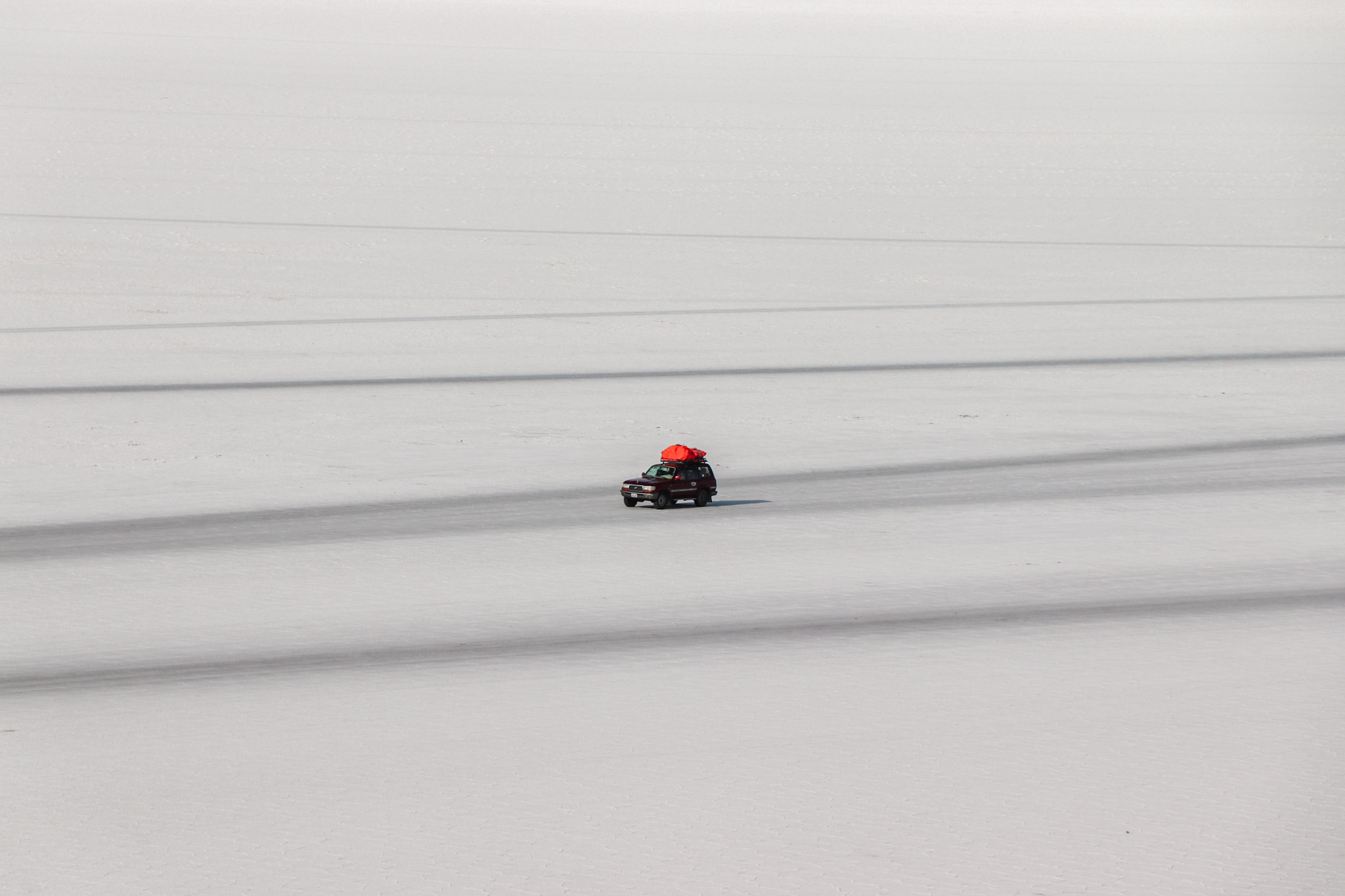
How much does an Uyuni Salt Flat tour cost?
Half-day-tours to Uyuni Salt Flat start from 35 USD and standard shared 3-day-tours from 125 USD. However, note that these prices are for the Spanish-speaking tours. In case you prefer to have an English-speaking guide, you will have to pay about 400 BOB (≈ 60 USD) per person extra.
Yes, an English-speaking guide comes with a hefty extra cost. Also, we were discussing whether it was worth the additional price tag. Our recommendation is this: Book a Spanish tour and save some bucks. Almost nobody in our group spoke Spanish and because the guides are super helpful, you won’t miss out on much.
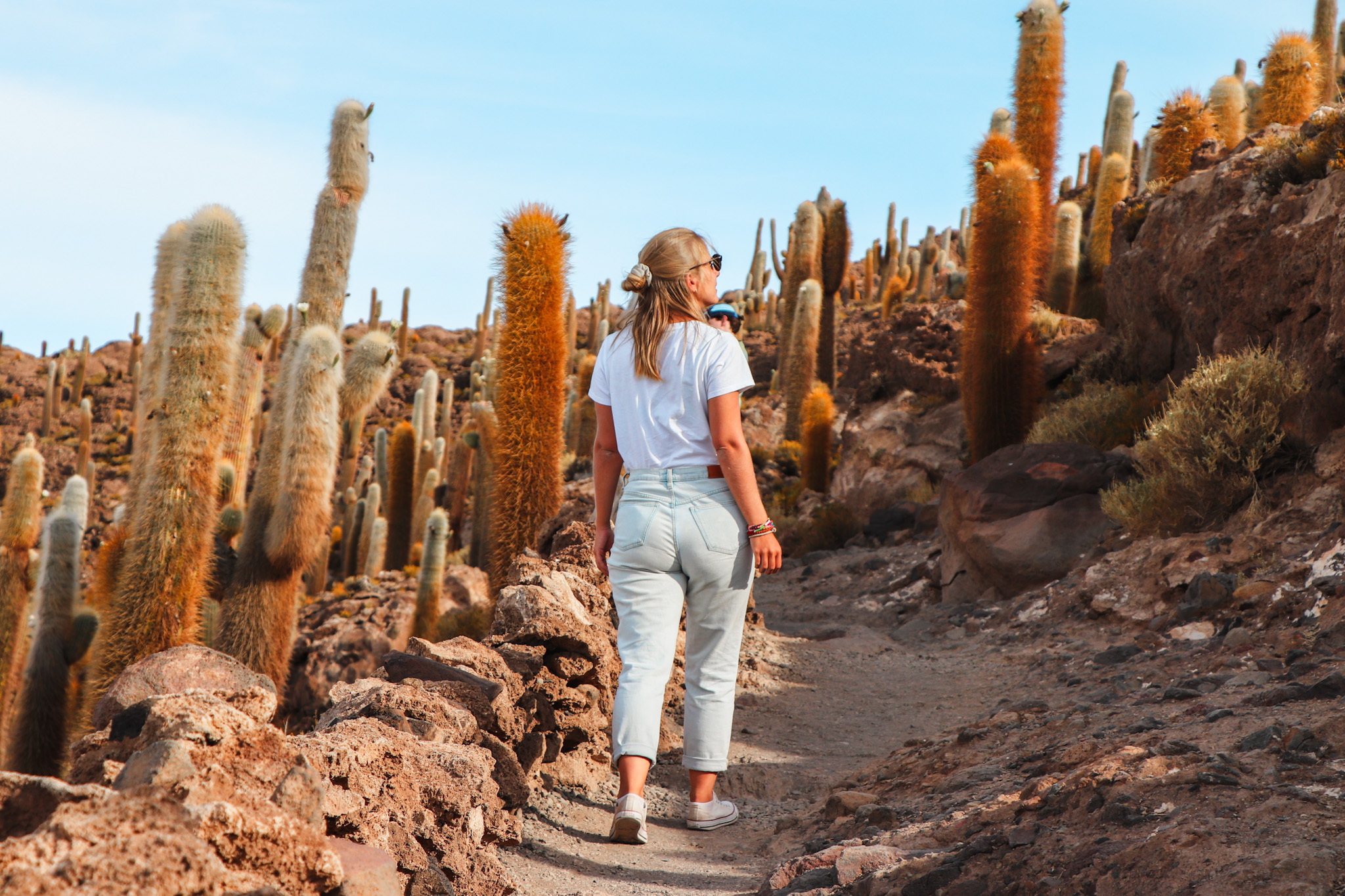
Most tours let you upgrade sleeping in private rooms instead of shared ones, which costs an extra 25 USD per person. We didn’t think it was worth the 50 USD extra, but that depends on your personal preference. Because everybody in our group had private rooms, we were lucky to also get one (just with lower standards).
Entrance fees are usually not included in the tour price. So you’d want to make sure to bring at least 200 BOB (≈ 30 USD) of cash to pay for water, snacks, and fees:
Isla Incahuasi | 30 BOB (≈ 5 USD)
Eduardo Avaroa National Reserve | 150 BOB (≈ 23 USD)
Hot springs | 15 BOB (≈ 2 USD)
If you’re planning to continue your travels to Chile after visiting Uyuni, consider booking a 3-day tour. For an additional cost of 15-20 USD, tour operators will assist you in crossing the border on the last day and arrange transportation to San Pedro de Atacama.
Keep in mind that tour operators often charge a 5-7% service fee for card payments. In case you’d like to avoid that, there is one Banco Union ATM in Uyuni. But expect to wait for a while as whenever we passed by the ATM, there was a long queue.
To get the cheapest price, do not book your tour online before you are in Uyuni. Just reach out to agencies via WhatsApp the day before to compare prices. Showing up at the agency on the same morning may even mean you get a private room without extra cost.

What to expect from the tour to Salar de Uyuni?
Crowds | To set your expectations – in the high season, about 50 cars are starting every day from Uyuni town, so it sometimes gets quite crowded. Though it did not bother us too much, as our guide always tried to arrive to the sights a bit later, when most of the tours already started leaving.
Cars | Be prepared to spend a lot of time in the car driving from one destination to another. For us, it never got boring as we enjoyed watching the colorful landscapes passing by. Just be prepared that there’s not much legroom and you will have to keep your small backpack on your lap/at your feet all the time. Luckily there are several stops along the day to stretch your legs.
Be also prepared that occasionally also some cars break down as these landscapes show no mercy. But the guides are great mechanics and they will identify and fix the problem in no time.

Hotel | Most tours stay in a salt hotel on the first night, where all the walls, floor and even furniture are made from blocks of salt! Expect the facilities to be rather basic. After all, you are sleeping in the middle of nowhere. Where exactly you sleep is dependent on your tour operator, so we can’t list the places. Make sure to check with the agency about what is included. Some offer only private rooms, others have the option to upgrade to a private room. Sometimes there are only shared bathrooms, sometimes you will have to pay for a warm shower. These are some things you should look for.
Power Plugs | Also regarding options to charge your devices, it is very dependent on your operator. We were lucky and had power plugs in our room on the first night, but on the second one we only had electricity when the generator was working (until we went to sleep).
Internet | Don’t expect to have any Wi-Fi or cell reception during the tour. This is your real digital detox time!
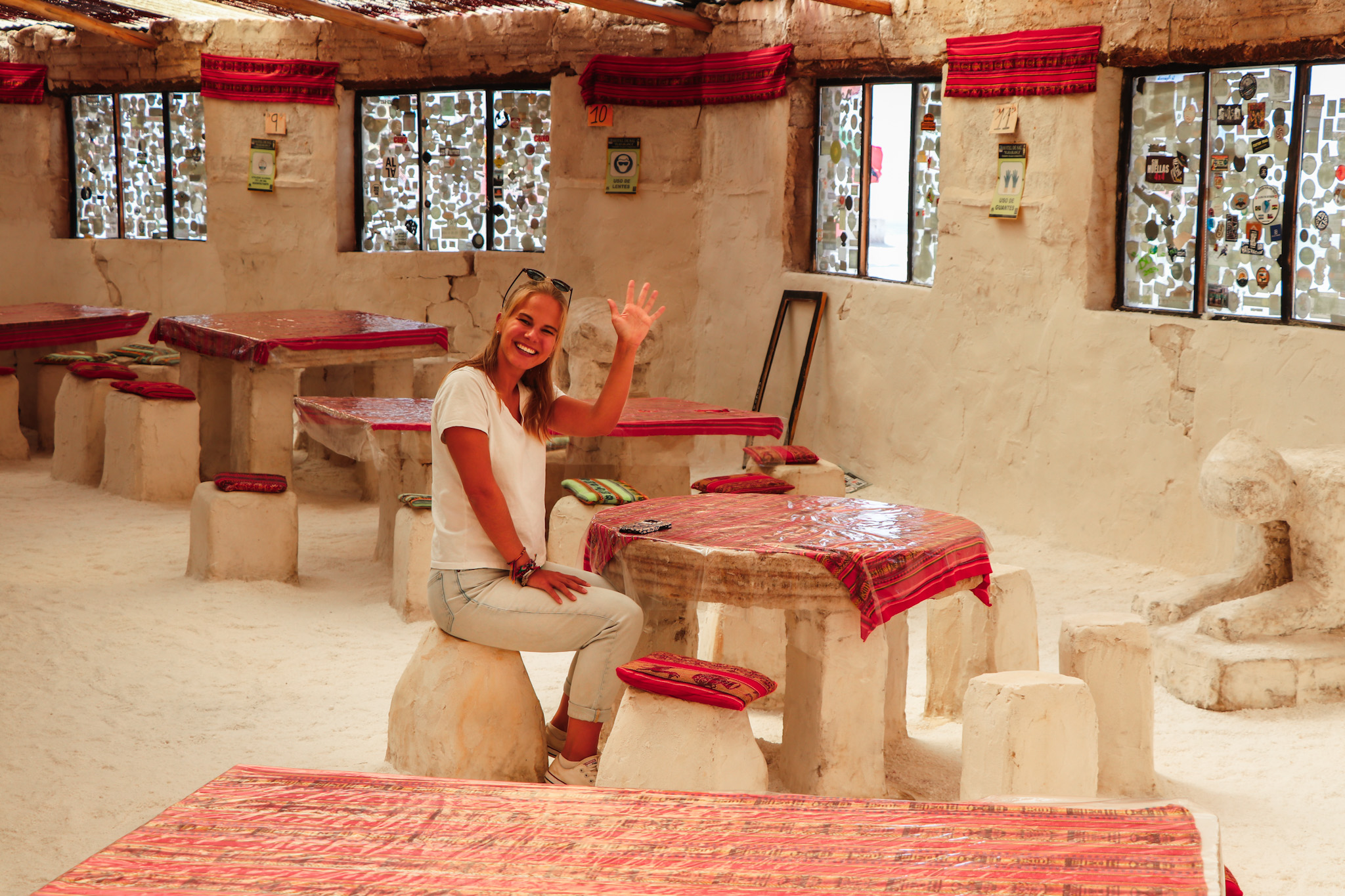
Meals | There are three meals per day included in your tour. As we had read from some reviews that the portions are often small, we brought some snacks with us. However, we found the food to be rather tasty and more than enough.
Water | Keep in mind that drinking water is only provided during meals. So, you want to bring enough with you for the first day and buy some more along the way.
Toilets | To our surprise, the greatest struggle during our tour was going to the toilet. Whereas there were quite a few toilets available, the cost was often 7 BOB (≈ 1 USD), which just seemed way too overpriced. Even the most expensive toilets on German Autobahns don’t cost that much! So often we ended up going behind bushes or rocks, but that’s up to you.
Altitude Sickness | The Salt Flat tour will lead you to breathtaking heights, with Salar de Uyuni sitting at an altitude of 3,656 meters (11,995 feet) above sea level and the highest point reaching 5,000 meters (16,404 feet) meters at the geysers. Although the tour is not physically demanding, you will feel the thinner air still. If you have the chance, acclimatize for higher altitudes by spending at least one or two nights in La Paz or Uyuni town before starting your tour. Remember to drink lots of water and try to avoid heavy meals.

How to get to Uyuni?
Getting to Uyuni is no big deal. It’s one of the main tourist attractions in Bolivia and hence there are many different ways to reach this beautiful place. Even though Uyuni is a small town, it is well-connected with most major cities by bus or plane. We’ll show you how to best get there.
From La Paz to Uyuni
From La Paz, you can take a 9-hour direct bus to Uyuni or – if you are on a tight schedule – jump on a one-hour flight from El Alto International Airport.
Overnight buses from La Paz to Uyuni leave from Terminal de Buses La Paz between 8:30 to 10:30 p.m. The bus ticket costs between 100 BOB (≈ 15 USD) and 180 BOB (≈ 27 USD), depending on the bus company you choose.
It’s best to look up the current bus schedules and buy your tickets in advance via Tickets Bolivia. The overnight buses in Bolivia are generally comfortable, offering much legroom and seats reclining about 160 degrees.
A direct flight from La Paz to Uyuni usually costs around 851 BOB (≈ 128 USD), so it’s fairly expensive compared to flying to other destinations in Bolivia. Also, if you decide to take the plane, keep in mind that there is only one flight to Uyuni every day, leaving early in the morning.
Relevant Reading
From Cochabamba to Uyuni
There are several direct overnight buses from Cochabamba to Uyuni. It really is a long ride that will take at least 11 hours.
To get to Uyuni from Cochabamba take one of the evening buses from the Terminal de Buses in Cochabamba. The bus ticket costs around 145 BOB (≈ 22 USD). Look for bus companies such as Panasur, Omar, and Autobuses Emperador. You can also find the current bus schedules and buy your tickets in advance on Tickets Bolivia.
Note that there are no direct flights from Cochabamba to Uyuni. So if you’d like to travel from Cochabamba to Uyuni by plane, you’ll have a stopover in La Paz.
Relevant Reading
From Sucre to Uyuni
You can easily travel from Sucre to Uyuni by bus. There are a few direct 8-hour overnight buses available which we recommend over traveling via and changing buses in Potosi which would surely take longer.
The night buses leave Sucre at 9 p.m. and 10 p.m. from Terminal de Buses Sucre. Look for companies 6 de Octubre and Autobuses Emperador. You can look up the current bus schedules and buy your tickets in advance on Tickets Bolivia.
Taking the plane from Sucre to Uyuni is no option. The only flights connecting both cities have two stopovers, one in Cochabamba and one in La Paz.
Relevant Reading
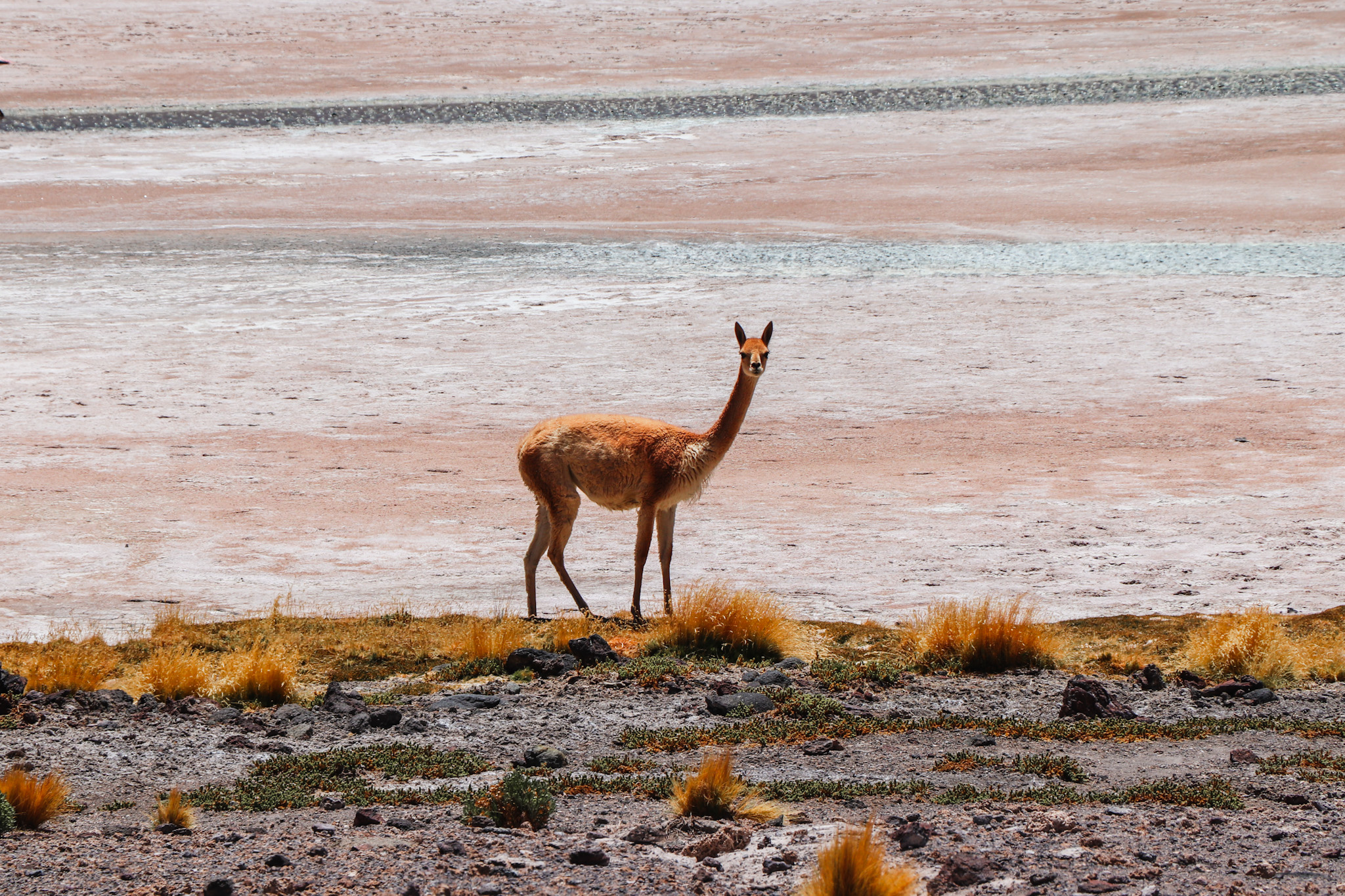
Where to stay in Uyuni?
Not many people stay in Uyuni town, usually heading directly to the salt flat when they arrive and leaving on the same evening after their tour finishes. As the tours usually start around 10 a.m., this is doable if you come with an overnight bus or an early flight.
However, we were pretty wasted after our (only) 8-hour bus ride from Cochabamba and wanted to take a day off before continuing to the Salt Flat. And if you’re a slow traveler too, then maybe some of our accommodation picks are for you.
What to pack for the Uyuni Salt Flat?
Something to note when planning your tour to Uyuni Salt Flat is that due to limited space in the car, only people who transfer to Chile are allowed to take their large luggage with them. Everyone who returns to Uyuni can only bring essential belongings and has to leave large luggage in the hostel in Uyuni or the agency.
That’s why we have prepared a compact packing list for your trip to the Salar de Uyuni.
We recommend dressing in layers as the weather can be unpredictable, with hot sun and strong winds being both very probable. Especially in case you are travelling during Bolivian winter, take some warm clothes and accessories such as a scarf, a hat and gloves with you, since at night temperatures drop to around -10°C (14°F) or even lower. In case you will be traveling during the wet season, rubber boots will be usually provided by the tour operator.
Don’t forget to bring lots of sun protection and also enough water with you for the first day because it is usually not provided by the tour operators. You can buy water along the way, in the small villages, but expect the prices to be higher. As not all the accommodations have electricity in the room, you might want to bring a power bank. Also bring at least 200 BOB (≈ 30 USD) in cash to pay for the tickets, but also for other services like toilets, to buy some water and snacks. And don’t forget your swimsuit in case you would like to jump into the hot springs.
Here is our packing list for the Uyuni Salt Flat tour:
When is the best time to visit the Uyuni Salt Flat?
The “best” time to visit the Uyuni Salt Flat truly depends on what you’re looking for in your experience.
The peak tourist season is the dry season from May to November when the days are warm and sunny and nights comfortable. As the roads are generally more accessible, the probability is higher that you can explore the entire salt flat and surrounding areas.
However, if it is on your bucket list to take stunning pictures with the mesmerizing mirror effect, you will have to visit Uyuni during the wet season from January to March.
Just note that some roads may become impassable due to flooding, restricting access to certain areas such as the Incawasi Island and you may have to come back to the Uyuni town for the night. Expect temperatures to be freezing at night and also bring a raincoat as it will rain occasionally (because without rain there wouldn’t be any reflections).
Is it worth visiting the Uyuni Salt Flat?
Salar de Uyuni is just as remarkable as the Sahara Desert and is a definite must-visit when in Bolivia. In fact, it was one of the highlights of our entire South American journey. We had never seen a landscape like it before.
Many tourists come here to witness the magical mirroring effect during the wet season (January to March), when the ground is covered with water, reflecting the sky and surroundings, creating an otherworldly experience. But don’t worry too much if that doesn’t fit your travel schedule; we found the views during the dry season absolutely breathtaking and well worth the trip.
Most importantly, don’t limit your tour to just visiting the Uyuni Salt Flat. For the greatest experience, we recommend taking a 2- or 3-day tour to also explore the stunning surrounding areas, including colorful lagoons filled with flamingos, majestic volcanoes, and geysers.
